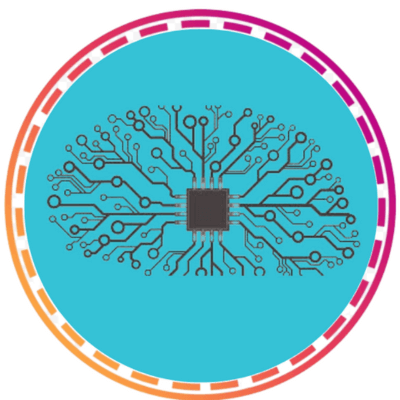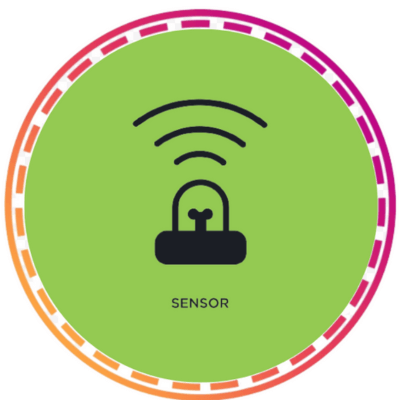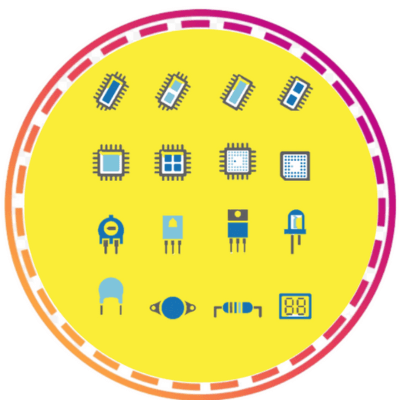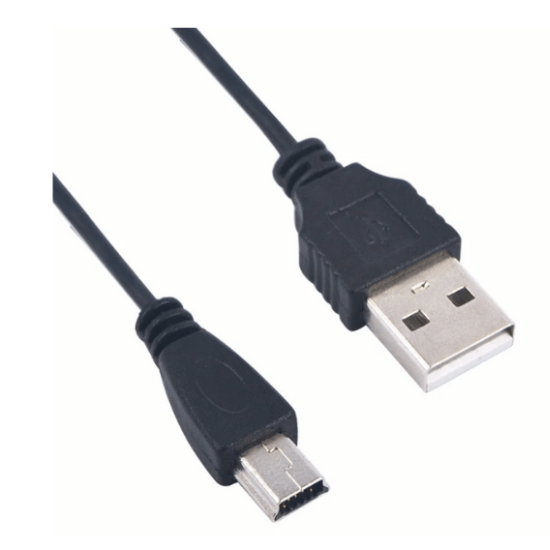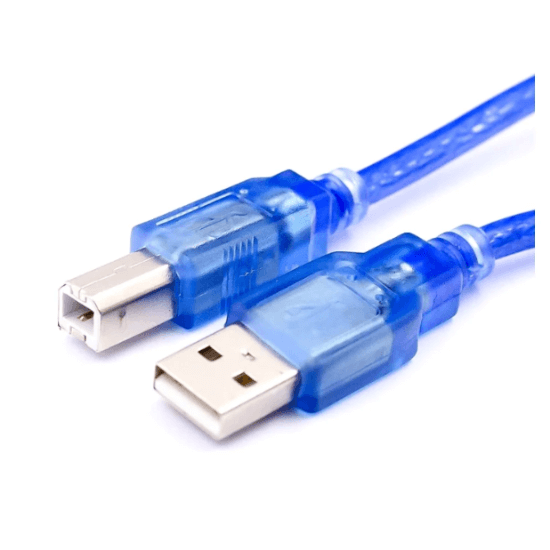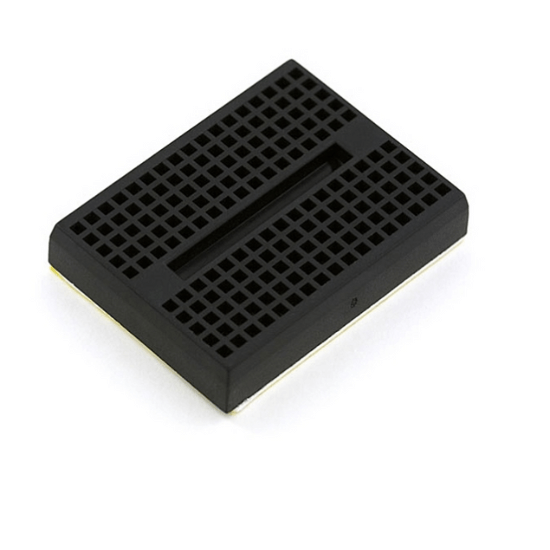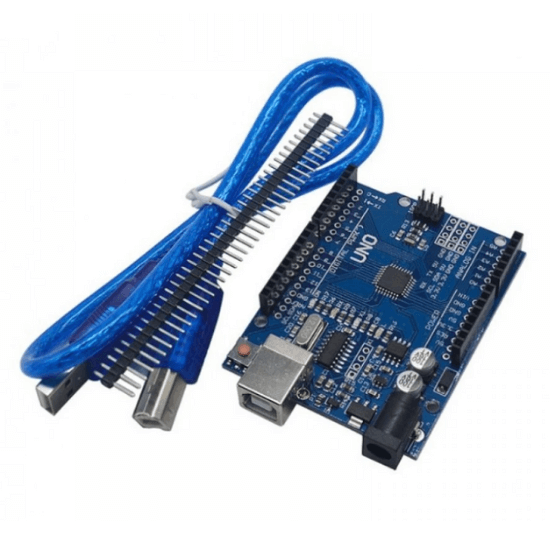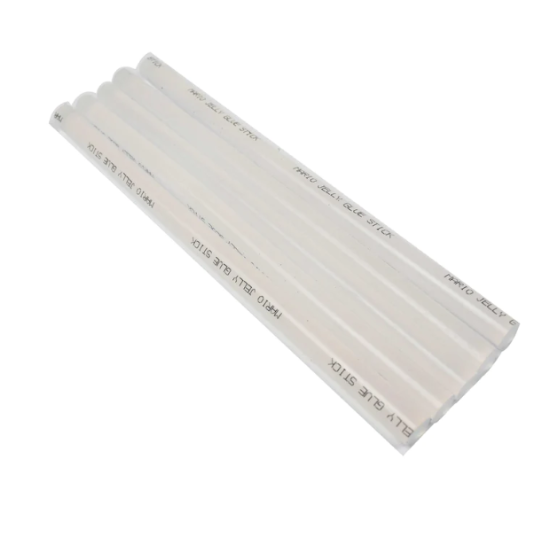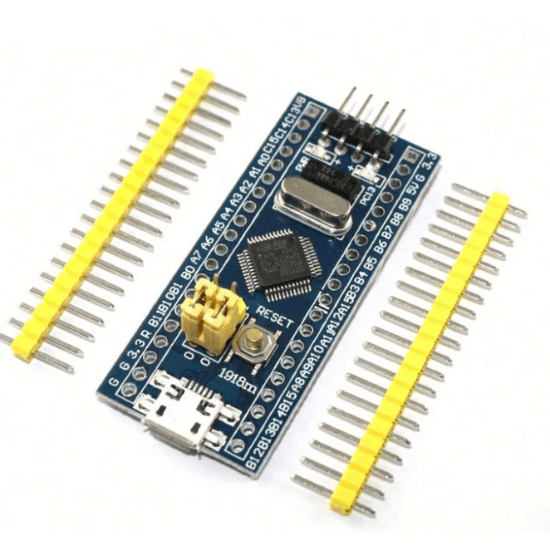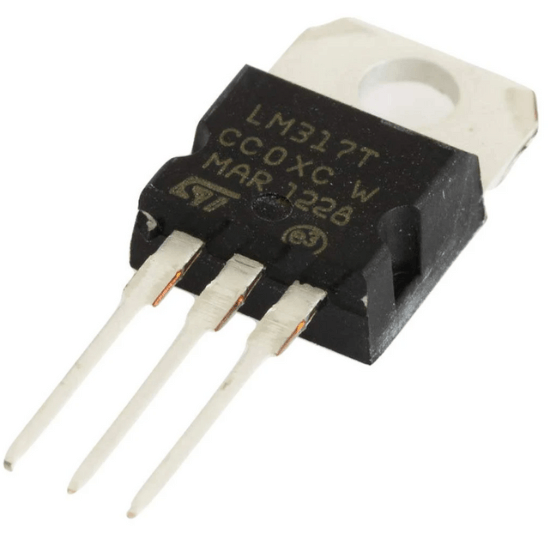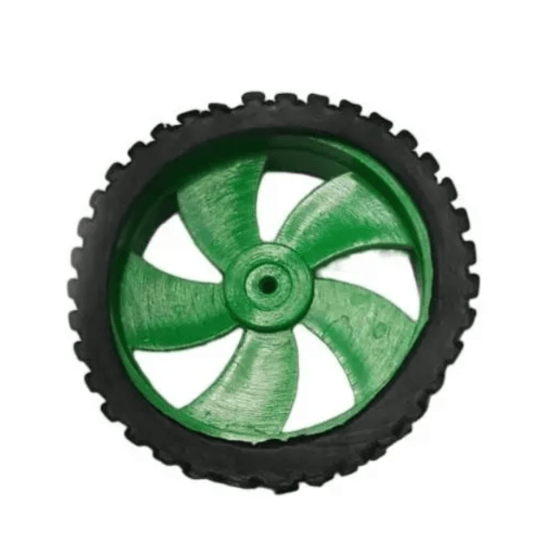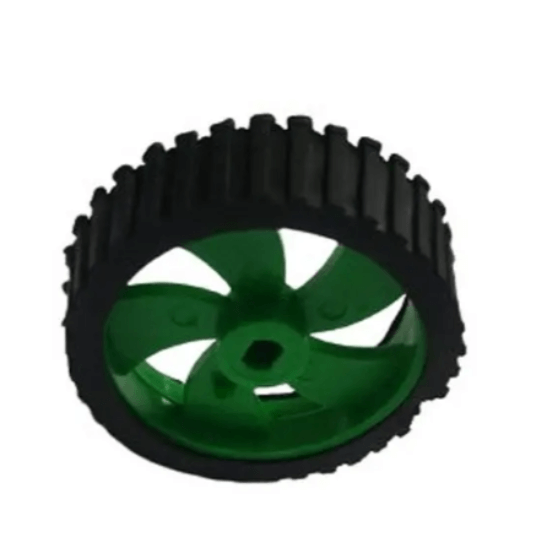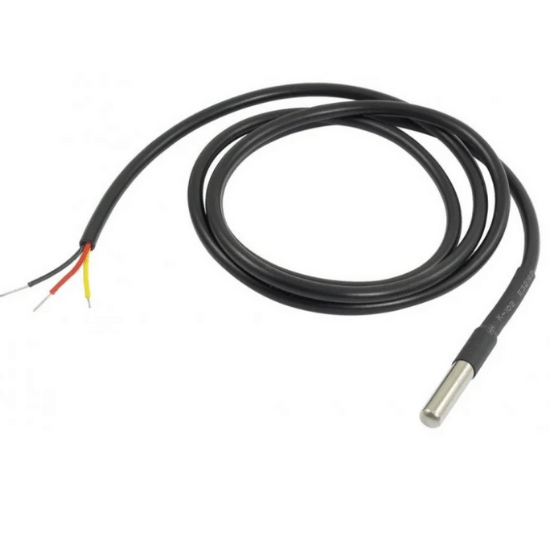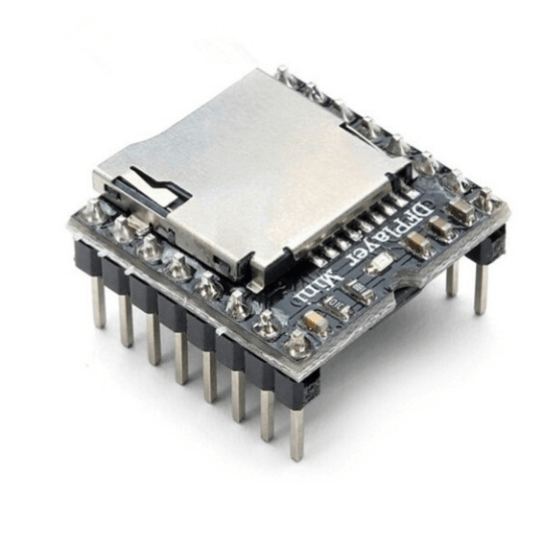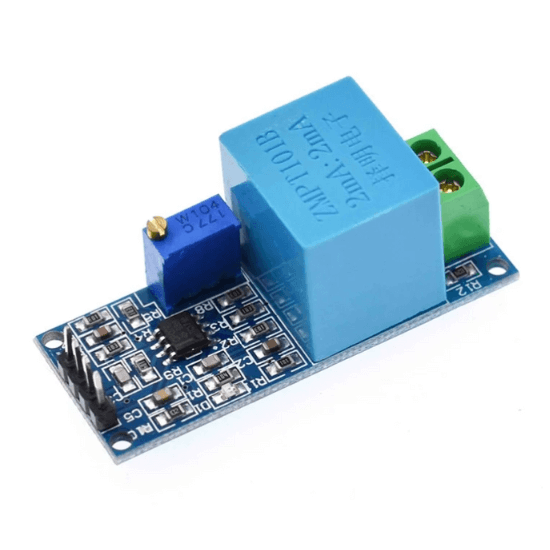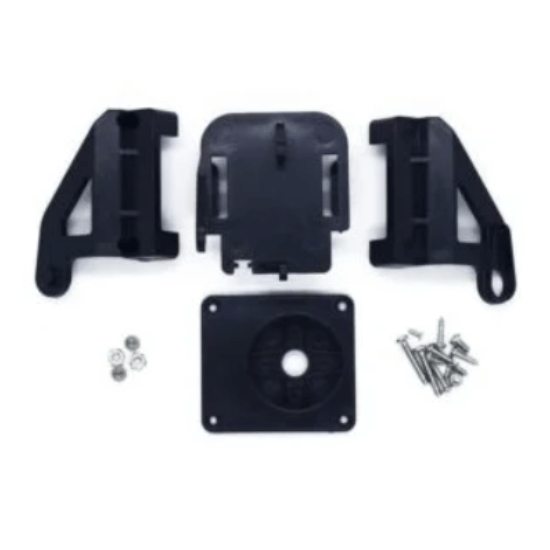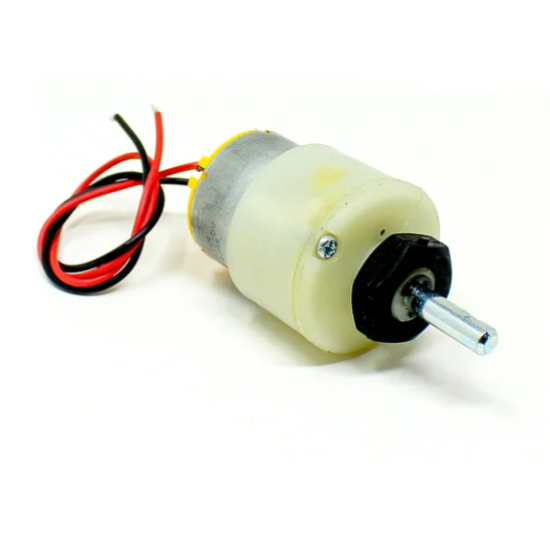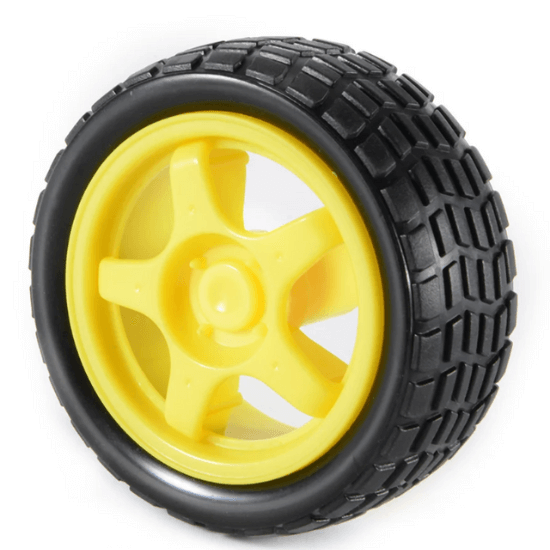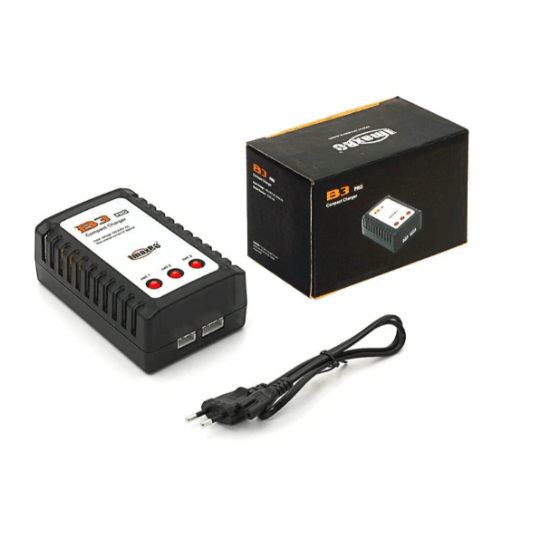Best Selling Products
All Products, AI Thinker WiFi Module
ESP32 Camera Development Board WiFi+Bluetooth Module with OV2640 Camera Module Standard Quality

All Products, AI Thinker WiFi Module
ESP32 Camera Development Board WiFi+Bluetooth Module with OV2640 Camera Module Standard Quality
0 out of 5
(0)
Flash LED off: 180mA @ 5V.
Flash LED on to maximum brightness: 310mA @ 5V.
Deep-sleep: 6mA @ 5V min.
Modem-sleep: 20mA @ 5V min.
Light-sleep: 6.7mA @ 5V min.
SKU: IK-223
All Products, Li-ion Battery
18650 1200maH Lithium Ion Battery – 0.5C Rating – 200 cycle Standard Quality

All Products, Li-ion Battery
18650 1200maH Lithium Ion Battery – 0.5C Rating – 200 cycle Standard Quality
0 out of 5
(0)
1200mah Lithium Ion Battery
Life Cycle: 200 Cycles
Charge / Discharge Rating: 0.5C
Form Factor: 18650
SKU: IK-265
All Products, Current/Voltage, Voltage Regulator
Voltage Detection Sensor Module 25V
0 out of 5
(0)
You can also use the IICLCD1602 LCD to display voltage.
By 3P connector, connect this module with the expansion of board Arduino
Voltage input range: DC 0-25 V
Voltage detection range: DC 0.02445 V to 25 V
Voltage analog resolution : 0.00489 V
SKU: IK-150
All Products, Arduino Boards
Arduino Uno R3 SMD Compatible Development Board(Without cable)
0 out of 5
(0)
Microcontroller ATmega328 (SMD) – Interface CH340G
Operating Voltage: 5V
Input Voltage (recommended): 7-12V
Input Voltage (limits): 5-20V
Digital I / O Pins 14 (of which 6 provide PWM output)
Analog Input Pins: 6
SKU: IK-112
All Products, Raspberry Pi, Raspberry Pi Boards
Raspberry Pi 4 Model B with 2 GB RAM Standard Quality

All Products, Raspberry Pi, Raspberry Pi Boards
Raspberry Pi 4 Model B with 2 GB RAM Standard Quality
0 out of 5
(0)
2GB/4GB Varients
Quad-Core 64-bit Broadcom 2711, Cortex A72 Processor
WLAN 802.11 b/g/n/ac (2,4 + 5,0 GHz)
LAN RJ45 10/100/1000 Mbit (Gigabit LAN over USB 3.0)
Operating Power 5V@3A via USB Type-C Port
SKU: IK-243
All Products, Arduino Kits, Custom Kits, Robot Kits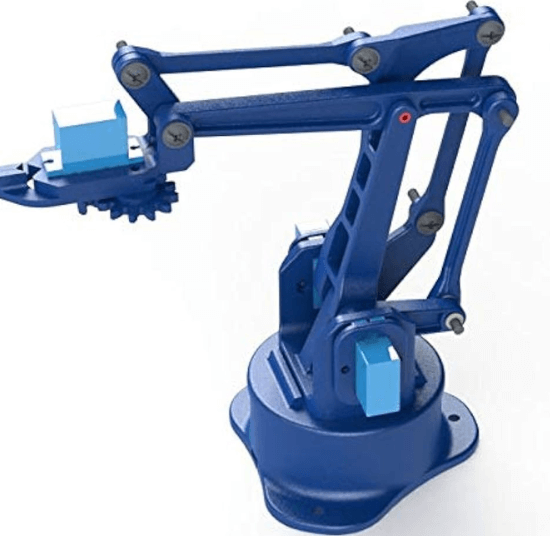
Robotic Arm 3D Printed Parts with Nuts and Bolts (Without Servo)

All Products, Arduino Kits, Custom Kits, Robot Kits
Robotic Arm 3D Printed Parts with Nuts and Bolts (Without Servo)
0 out of 5
(0)
DIY Robotic Arm KIT.
All nuts and bolts available.
Printed with PLA Pro Special Filament.
Compatible with Arduino.
Servos and controller Not Included.
SKU: IK-231
All Products, Distance/Proximity, Miscellaneous, Potentiometer
M274 Rotary Encoder 360 Degree Brick Sensor Module Good Quality

All Products, Distance/Proximity, Miscellaneous, Potentiometer
M274 Rotary Encoder 360 Degree Brick Sensor Module Good Quality
0 out of 5
(0)
Model : KY-040.
Type : Incremental Encoder.
Cycles per revolution (CPR) : 20.
Working voltage : 0 – 5V.
Material : PCB + Brass.
Mounting Nut Thread diameter: 6.6mm
Weight : 10 gm.
SKU: IK-175
All Products, Battery, Battery Holder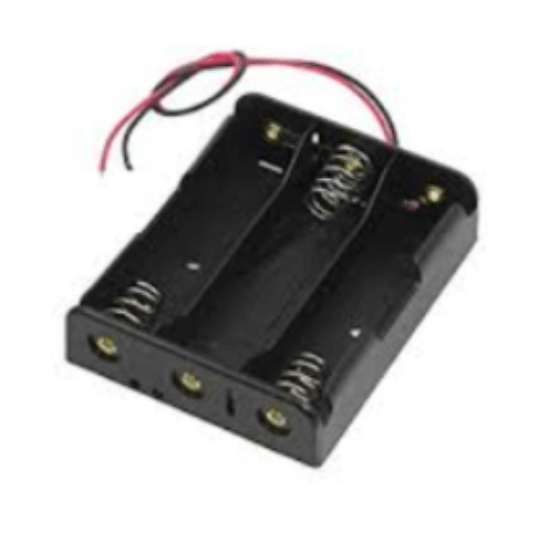
Cell Box/Black Plastic Storage Box Case Holder For Battery 3 x 18650, Without Cover Standard Quality

All Products, Battery, Battery Holder
Cell Box/Black Plastic Storage Box Case Holder For Battery 3 x 18650, Without Cover Standard Quality
0 out of 5
(0)
Hold 3 standard 18650 batteries.
Wire Length: 15 cm.
Output: 11.1 V.
Dimension (Appro.) : 76 x 60 x 18 mm.
Weight: 18 gm.
High-quality plastic material
SKU: IK-213
All Products, Servo Motor/Controller
TowerPro SG90 Continuous Rotation 360 Degree Servo Motor Standard Quality

All Products, Servo Motor/Controller
TowerPro SG90 Continuous Rotation 360 Degree Servo Motor Standard Quality
0 out of 5
(0)
Model: SG90
Weight: 9 gm
Operating voltage: 3.0V~ 7.2V
Servo Plug: JR
Stall torque @4.8V : 1.2kg-cm
SKU: IK-126
12v Relay, All Products
4 Channel Relay Module (with light coupling) 5V
0 out of 5
(0)
Operating Voltage: 12V DC
Equipped with high-current relay 10A@250VAC / 10A@30VDC
It can control both AC and DC appliances such as Solenoids, Motors, lights, fans, etc
High-quality screw terminals (Terminal Block) provided (C, NC, NO) for quick and easy connection
Freewheeling diode to protect your microcontroller
Input Signal Pin connected to Burg stick for easy accessibility
LED Status indicators to indicate the relay ON/OFF status
Mounting holes provided
SKU: IK-131
All Products, Cables & Connector, Jumper Wires
Male to Female Jumper Wires 40 Pin 30cm Standard Quality

All Products, Cables & Connector, Jumper Wires
Male to Female Jumper Wires 40 Pin 30cm Standard Quality
0 out of 5
(0)
40P color jumper wires
Length: 300mm
Weight: 45 gm
Compatible with 2.54mm spacing pin headers
High quality and in good working condition
Durable and reusable
Easy to install and use
SKU: IK-135
All Products, ESP8266 Boards
ESP8266 NodeMCU CP2102 Board
0 out of 5
(0)
Open-source, Interactive, Programmable, Low cost, Simple, Smart, WI-FI enabled
Arduino-like hardware IO
Integrated TR switch, balun, LNA, power amplifier and matching network
Integrated PLL, regulators, DCXO and power management units
Onboard USB to serial chip to easily program and upload codes from the Arduino IDE
Embeds logic level converter circuits
Has onboard 3.3V regulator to ensure enough power to function as your go-to WiFi chip!
Easy access to the GPIO pins for easy prototyping
ESP-12E Processor
Easy to use breadboard friendly form factor
SKU: IK-102
All Products, Arduino Boards
Arduino Nano R3 Compatible Board with CH340 chip(Unsoldered)
0 out of 5
(0)
Operating Voltage (logic level): 5V
With Soldered Connector
8 analog inputs ports: A0 ~ A7
14 Digital input / output ports: TX, RX, D2 ~ D13
1 pair of TTL level serial transceiver ports RX / TX
Using Atmel Atmega328P-AU MCU
There is a bootloader installed in it
Standard 0.1” spacing DIP (breadboard friendly).
Manual reset switch.
SKU: IK-115
All Products, Cables & Connector, Jumper Wires
Male to Male Jumper Wires 40 Pin 30cm Standard Quality

All Products, Cables & Connector, Jumper Wires
Male to Male Jumper Wires 40 Pin 30cm Standard Quality
0 out of 5
(0)
40P Color Jumper Wire
Length: 400mm
Weight: 56 gm
Compatible with 2.54mm spacing pin headers
40pcs chromatic male to male color jump wire
High quality and in good working condition
Durable and reusable
Easy to install and use
SKU: IK-136
All Products
GPRS SIM800L GSM Module Core Board Quad-band TTL Serial Port with the antenna Standard Quality

All Products
GPRS SIM800L GSM Module Core Board Quad-band TTL Serial Port with the antenna Standard Quality
0 out of 5
(0)
TTL serial port for serial port, you can link directly to the micro-controller.
Don’t need MAX232.
Power module automatically boots, homing network.
Onboard signal lights all the way.
It flashes slowly when there is a signal, it flashes quickly when there is no signal.
SKU: IK-166
All Products, Arduino Boards
Arduino Uno R3 SMD Compatible Development Board(With cable)
0 out of 5
(0)
Microcontroller ATmega328 (SMD) – Interface CH340G
Operating Voltage: 5V
Input Voltage (recommended): 7-12V
Input Voltage (limits): 5-20V
Digital I / O Pins 14 (of which 6 provide PWM output)
Analog Input Pins: 6
SKU: IK-268
All Products, 5V Relay
5V Dual Channel Relay Module with Optocoupler
0 out of 5
(0)
Low Level Trigger Relay Module
Two separate LEDs for On/Off indication of the Relay.
Triggering input voltage 3.3V – 5V
Two separate LEDs for On/Off indication of the Relay
Triggering input voltage 3.3V – 5V 4)
Back EMF protection
Back EMF protection 2 LEDs to indicate when relays are ON.
Works with logic level signals from 3.3V or 5V devices
Opto isolation circuitry
Module with diode current protection, short response time
AC Control Voltage: 250V @max.10A
DC Control Voltage: 30V @max. 10A
SKU: IK-130
All Products, RF/NRF Module
2.4GHz NRF24L01+PA+LNA SMA Wireless Transceiver Antenna
0 out of 5
(0)
Voltage: 3-3.6V (recommended 3.3V) V.
Maximum output power: +20dBm.
Power-down mode current: 4.2uA.
Operating Range: 1Km
Antenna Gain (peak): 2Dbi.
2MB rate (Open area): 520m.
1MB rate (Open area): 750m.
250Kb rate (Open area): 1100m.
It uses 2.4GHz global open ISM band, with license free.
SPI interface facilitates the communication with MCU I/O port.
SKU: IK-140
All Products, RF/NRF Module
3.3V Adapter Board for 24L01 Wireless Module
0 out of 5
(0)
It can be used with NRF24L01 wireless module
Add core nRF24L01+ Breakout Adapter with onboard 3.3V Regulator
Onboard 3.3V voltage regulator accepts your Arduino +5V supply and provides 3.3V for the attached nRF24L01+ module
Allows for easy connection to nRF24L01+ modules
Small power on SMD LED indicator
SKU: IK-141
All Products
100 RPM Dual Shaft BO Motor-Straight
0 out of 5
(0)
Low density: lightweight, low inertia.
Capability to absorb shock and vibration as a result of elastic compliance.
Ability to operate with minimum or no lubrication, due to inherent lubricity.
The relatively low coefficient of friction.
Operating Voltage(VDC): 3~12
Shaft Length (mm): 8.5
Shaft Diameter (mm): 5.5 (Double D-type)
No Load Current: 40-180mA.
Rated Speed(After Reduction): 100 RPM
Rated Torque: 0.35 Kgcm
SKU: IK-209
All Products, Adapter, Power Supply, SMPS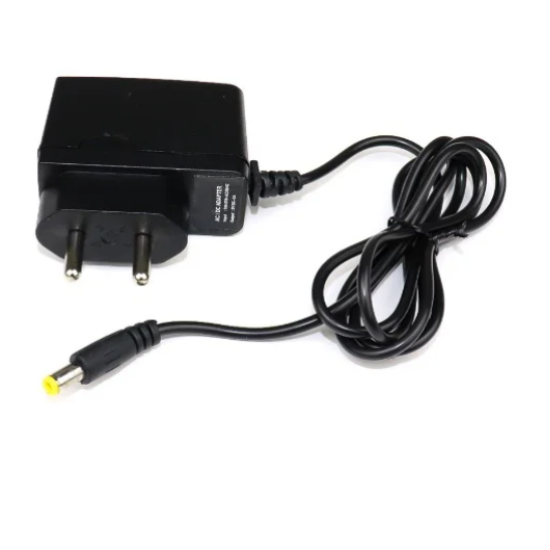
Standard DC Plug 5V 1A Power Supply with 5.5mm at Best Price

All Products, Adapter, Power Supply, SMPS
Standard DC Plug 5V 1A Power Supply with 5.5mm at Best Price
0 out of 5
(0)
Input Voltage (V): 100 ~ 280 VAC @50 ~ 60Hz.
Input current (mA): 100.
Output Power: 5V 1A.
Input Plug: 2-Pin EU type.
Output Plug: 5.5mm DC plug.
SKU: IK-334
All Products, Light/Colour
LM393 Photosensitive Light-Dependent Control Sensor LDR Module
0 out of 5
(0)
LDR module 4 PIN
Operating voltage 3.3V-5V
Signal output indicator light.
LDR module 4 PIN
Able to detect ambient brightness and light intensity Adjustable sensitivity (via blue digital potentiometer adjustment)
SKU: IK-187
Development Boards Products
All Products, Arduino Boards
Arduino Uno R3 SMD Compatible Development Board(With cable)
0 out of 5
(0)
Microcontroller ATmega328 (SMD) – Interface CH340G
Operating Voltage: 5V
Input Voltage (recommended): 7-12V
Input Voltage (limits): 5-20V
Digital I / O Pins 14 (of which 6 provide PWM output)
Analog Input Pins: 6
SKU: IK-268
All Products, Development Boards, Raspberry Pi, Raspberry Pi Boards
Raspberry Pi Pico W No.1 Quality
0 out of 5
(0)
RP2040 microcontroller with 2MB of flash memory
On-board single-band 2.4GHz wireless interfaces (802.11n)
Micro USB B port for power and data (and for reprogramming the flash)
40 pin 21mmx51mm ‘DIP’ style 1mm thick PCB
Exposes 26 multi-function 3.3V general purpose I/O (GPIO)
23 GPIO are digital-only, with three also being ADC capable
SKU: IK-233
All Products, Accessories, Accessories, Arduino, Development Boards, Miscellaneous, Sensors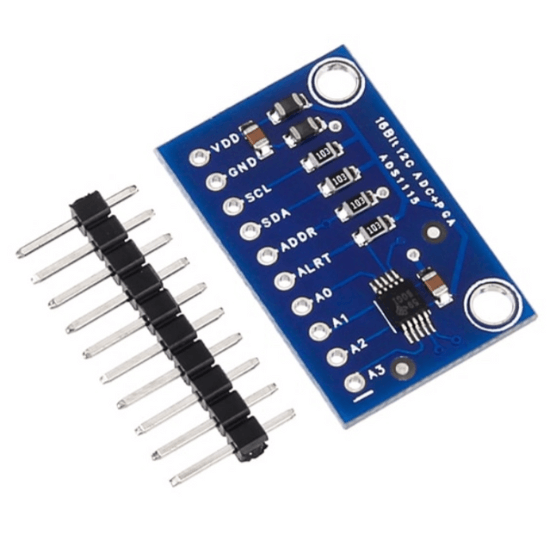
ADS1115 16-Bit ADC- 4 Channel with Programmable Gain Amplifier Standard Quality

All Products, Accessories, Accessories, Arduino, Development Boards, Miscellaneous, Sensors
ADS1115 16-Bit ADC- 4 Channel with Programmable Gain Amplifier Standard Quality
0 out of 5
(0)
Wide Supply Range: 2.0v To 5.5v
Low Current Consumption
Continuous Mode: Only 150µa Single-shot
Auto Shut-down
Programmable Data Rate: 8SPS to 860SPS
It has Internal low-drift voltage reference
SKU: IK-172
All Products, Accessories, Arduino, Arduino Boards, Arduino Shields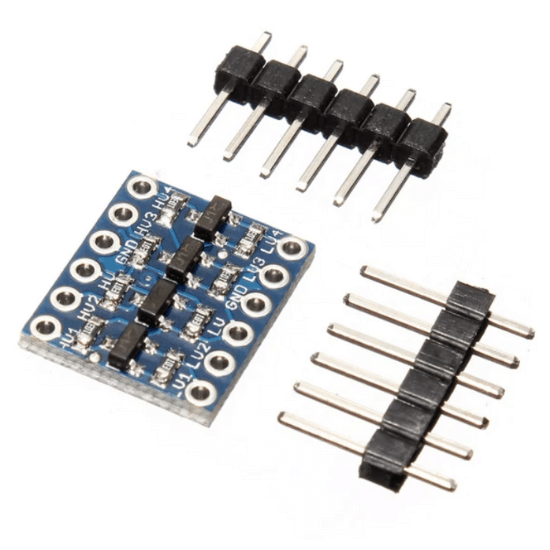
I2C Bi-Directional logic Level Converter- 4 Channel

All Products, Accessories, Arduino, Arduino Boards, Arduino Shields
I2C Bi-Directional logic Level Converter- 4 Channel
0 out of 5
(0)
Material: ABS + metal
Dimensions: 16 x13 x 3 (L x W x H) mm
Weight: 2gm
Mutual transform between 5V TTL and 3.3V TTL
Four channels of logic and high voltage low voltage logic can two-way transform
Portable and lightness, with 2 rows 6 pin contact pins
SKU: IK-160
All Products, Accessories, Keyboard & Mouse, Pressure/Touch, Switches & Keypads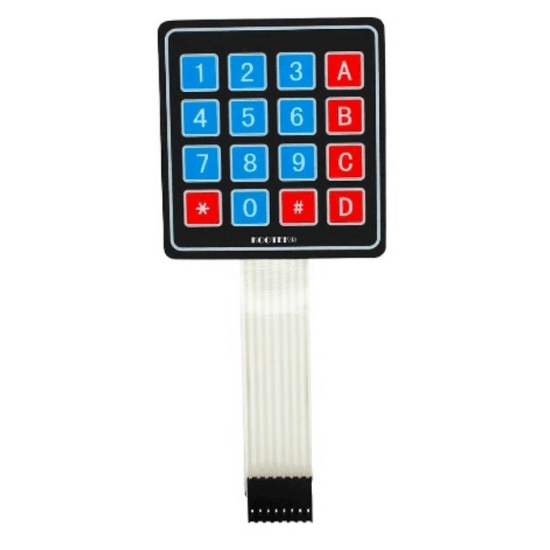
4×4 Matrix Keypad Membrane Switch for Arduino, ARM and other MCU

All Products, Accessories, Keyboard & Mouse, Pressure/Touch, Switches & Keypads
4×4 Matrix Keypad Membrane Switch for Arduino, ARM and other MCU
0 out of 5
(0)
Ultra-thin design & adhesive backing provides easy integration to any project
Excellent price-performance ratio
Easy communication with any microcontroller
5 pins 2.54mm pitch connector, 4x 4type 16 keys.
Sticker can peel off for adhesive mounting.
Operating Voltage (V): 12 DC
SKU: IK-138
All Products, Accessories, Motors & Mechanicals, Power Supply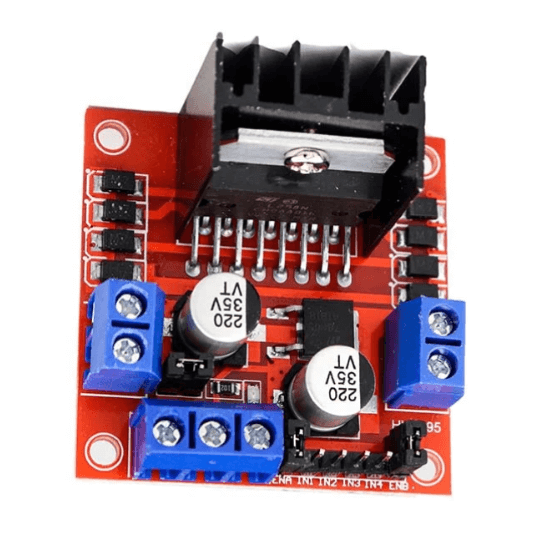
L298n Motor Driver 2A Based Module – Good Quality

All Products, Accessories, Motors & Mechanicals, Power Supply
L298n Motor Driver 2A Based Module – Good Quality
0 out of 5
(0)
Current Sense for each motor.
Heatsink for better performance.
Power-On LED indicator.
Double H bridge Drive Chip: L298N.
Operating Voltage(VDC): 5~35
Peak Current (A): 2
Continuous Current (A): 0-36mA
No. of Channels: 2
Over-Current Protection (A): Yes
Thermal Protection: Yes
SKU: IK-132
All Products, Accessories, Clock & Timer ICs, RFID/NFC
Real Time Clock RTC DS1307 Module AT24C32 without Battery Standard Quality

All Products, Accessories, Clock & Timer ICs, RFID/NFC
Real Time Clock RTC DS1307 Module AT24C32 without Battery Standard Quality
0 out of 5
(0)
Two-wire I2C interface.
Hour: Minutes: Seconds AM/PM.
Day Month, Date – Year.
DS1307-based RTC (Battery not include).
1Hz output pin.
Available in 8-pin DIP or SOIC
SKU: IK-122
All Products, Accessories, Miscellaneous, SD Cards
Micro SD Card Reader Module
0 out of 5
(0)
Power supply: 4.5V – 5.5V, 3.3V voltage regulator circuit board
Positioning holes: 4 M2 screws positioning hole diameter of 2.2mm
Control Interface: GND, VCC, MISO, MOSI, SCK, CS
Size: 45 x 28mm
Net weight: 6g
SKU: IK-148
All Products, Accessories, Accessories, AI Thinker WiFi Module, ESP Boards
USB TO UART TTL 5V 3.3V FT232RL Download Cable To Serial Adapter Module For Arduino Standard Quality

All Products, Accessories, Accessories, AI Thinker WiFi Module, ESP Boards
USB TO UART TTL 5V 3.3V FT232RL Download Cable To Serial Adapter Module For Arduino Standard Quality
0 out of 5
(0)
Standard interface layout, compatible with a variety of Arduinos such as the Pro Mini
Original FTDI FT232 chip, stable performance
USB power has current protection, using 500MA self-restore fuse
RXD/TXD transceiver communication indicator
With power, sending, receiving indicator, working status LED indicators
Mini USB Port Connection
Support 3.3V, 5V
SKU: IK-146
All Products, Accessories, AI Thinker WiFi Module, Miscellaneous
CP2102(6-pin) USB 2.0 to TTL UART serial converter

All Products, Accessories, AI Thinker WiFi Module, Miscellaneous
CP2102(6-pin) USB 2.0 to TTL UART serial converter
0 out of 5
(0)
Brand new and high quality
Included USB transceiver, without external circuit device
With 3.3V and 5V dual power output
With three LEDs: power indicator, data reception indicator, the data transmission indicator, working status
Meets the USB2.0 specification requirements
With self-recovery fuse. In the event of the accidental short circuit, it can effectively protect your computer USB port and Downloader
Asynchronous serial data bus compatible with all handshake and modulation controller interface signals
The supported data format is 8 data bits, 1 stop bit and parity bits
SKU: n/a
Accessories, AI Thinker WiFi Module, All Products, Miscellaneous
CH340G USB To TTL(Serial) Converter For Arduino Nano Raspberry Pi

Accessories, AI Thinker WiFi Module, All Products, Miscellaneous
CH340G USB To TTL(Serial) Converter For Arduino Nano Raspberry Pi
0 out of 5
(0)
Built-in USB to TTL Transfer chip.
Designed to be used for USB to TTL electronic projects.
TTL interface output, easy to connect to your MCU.
Dual 3.3V and 5V Power output, work with 3.3v and 5 V target device.
The mini-module is designed specifically for STC download and ARDUINO PRO supports all series of STC
Supports WIN7/VISTA/MAC/LINUX(32 bit /64-bit system)
SKU: n/a
All Products, Arduino Shields, Motor Drivers, Stepper Motor/ Controller
A4988 driver Stepper Motor Driver at Best Price

All Products, Arduino Shields, Motor Drivers, Stepper Motor/ Controller
A4988 driver Stepper Motor Driver at Best Price
0 out of 5
(0)
Supply Voltage : 8-35 VDC.
Current : 1.0A (no heatsink ).
Current : 2.0A (with heat-sinking).
logic input : 3 – 5.5V .
Automatic current decay mode detection / choice.
Mixed with slow current decay mode.
SKU: IK-216
All Products, Accessories
Transparent Acrylic Case For Arduino UNO R3 at Best Price
0 out of 5
(0)
Protective case of Arduino Uno.
Color: Transparent.
Fastened by eight screws.
Made by high grade acrylic.
Provides excellent protection, with fashion appearance.
Unique design for Uno with pin leakage, which provides easy connection to other components.
SKU: IK-222
All Products, Arduino, Arduino Boards
Arduino LilyPad 328 Main Board Standard Quality
0 out of 5
(0)
Microcontroller: ATmega168 or ATmega328V
Operating Voltage: 2.7-5.5 V
Digital I/O Pins: 14
PWM Channels: 6
Analog Input Channels: 6
DC Current per I/O Pin: 40 mA
Board will run from 2V to 5V.
The latest version of the LilyPad supports automatic reset for even easier programming.
The back side of the LilyPad is now completely flat!
SKU: IK-245
All Products, Arduino Shields
L293D Motor Driver Shield For Arduino Standard Quality
0 out of 5
(0)
2 connections for 5V ‘hobby’ servos connected to the Arduino’s high-resolution dedicated timer
4 H-Bridges: L293D chipset provides 0.6A per bridge (1.2A peak) with thermal shutdown protection, internal kickback protection diodes.
Can run motors on 4.5VDC to 25VDC.
Up to 4 bi-directional DC motors with individual 8-bit speed selection (so, about 0.5% resolution)
Up to 2 stepper motors (unipolar or bipolar) with single coil, double coil, or interleaved stepping.
SKU: IK-133
All Products, Arduino Shields
CNC Shield V3 for Engraving Machine 3D Printer A4988 DRV8825 Driver Expansion Board

All Products, Arduino Shields
CNC Shield V3 for Engraving Machine 3D Printer A4988 DRV8825 Driver Expansion Board
0 out of 5
(0)
Latest Arduino CNC Shield Version 3.10
GRBL 0.9 compatible. (Open source firmware that runs on an Arduino UNO that turns G-code commands into stepper signals)
Coolant enable
Jumpers to set the Micro-Stepping for the stepper drivers. (Some drivers like the DRV8825 can do up to 1/32 micro-stepping )
Compact design.
4-Axis support (X, Y, Z, A-Can duplicate X, Y, Z or do a full 4th axis with custom firmware using pins D12 and D13)
2 x End stops for each axis (6 in total)
SKU: IK-109
All Products, Arduino Boards
Arduino Uno R3 SMD Compatible Development Board(Without cable)
0 out of 5
(0)
Microcontroller ATmega328 (SMD) – Interface CH340G
Operating Voltage: 5V
Input Voltage (recommended): 7-12V
Input Voltage (limits): 5-20V
Digital I / O Pins 14 (of which 6 provide PWM output)
Analog Input Pins: 6
SKU: IK-112
All Products, Arduino Boards
Arduino Mega 16U2 Original board 2560 R3 with Compatible USB Cable
0 out of 5
(0)
54 Digital I/O terminals (14 of which have programmable PWM outputs).
16 Analog Inputs.
4 UARTs (hardware serial ports).
16 MHz crystal clock.
Operating voltage: 6 ~ 12v.
Dimensions: 110 x 53 x 15 mm.
SKU: IK-114
All Products, Arduino Boards
Pro Mini ATMEGA328P 5V/16M (Official Version)
0 out of 5
(0)
Microcontroller: ATmega328P
Circuit Operating Voltage: 5V
Clock frequency: 16MHz.
6 PWM port: D3, D5, D6, D9, D10, D11.
Use For Atmel Atmega328P-AU microcontroller.
Support serial download.
Support 9V battery.
A pair of TTL level serial port transceiver : RX / TX.
SKU: IK-117
All Products, Raspberry Pi, Raspberry Pi Boards
Raspberry Pi Zero W (Wireless) With In-Built Wifi and Bluetooth No.1 Quality

All Products, Raspberry Pi, Raspberry Pi Boards
Raspberry Pi 4 Model B with 2 GB RAM Standard Quality

All Products, Raspberry Pi, Raspberry Pi Boards
Raspberry Pi 4 Model B with 2 GB RAM Standard Quality
0 out of 5
(0)
2GB/4GB Varients
Quad-Core 64-bit Broadcom 2711, Cortex A72 Processor
WLAN 802.11 b/g/n/ac (2,4 + 5,0 GHz)
LAN RJ45 10/100/1000 Mbit (Gigabit LAN over USB 3.0)
Operating Power 5V@3A via USB Type-C Port
SKU: IK-243
All Products, Raspberry Pi, Raspberry Pi Boards
Raspberry Pi Pico
0 out of 5
(0)
RP2040 microcontroller chip designed by Raspberry Pi
Dual-core Arm Cortex M0+ processor, the flexible clock running up to 133 MHz
264KB of SRAM, and 2MB of onboard Flash memory
26 × multi-function GPIO pins
2 × SPI, 2 × I2C, 2 × UART, 3 × 12-bit ADC, 16 × controllable PWM channels
Onboard temperature sensor
SKU: IK-218
All Products, Development Boards
ATTINY85 USB Development Board Good Quality
0 out of 5
(0)
Support for the Arduino IDE 1.0 + (OSX/Windows/Linux).
Power via USB or External Source or 7-16 v to 5 v (automatic selection).
The Onboard, 150 ma 5 v Regulator.
Built-in USB and serial were debugging).
6 I/O Pins (2 inform the for USB only if your program actively communicates over USB, otherwise you can use all 6 even if you are programming via USB).
8 k Flash Memory (about 6 k after bootloader).
The I2C and SPI (vis USI).
The Power LED and the Test/Status LEDs.
SKU: IK-164
All Products, Arduino Boards
Arduino Nano R3 Compatible Board with CH340 chip(Unsoldered)
0 out of 5
(0)
Operating Voltage (logic level): 5V
With Soldered Connector
8 analog inputs ports: A0 ~ A7
14 Digital input / output ports: TX, RX, D2 ~ D13
1 pair of TTL level serial transceiver ports RX / TX
Using Atmel Atmega328P-AU MCU
There is a bootloader installed in it
Standard 0.1” spacing DIP (breadboard friendly).
Manual reset switch.
SKU: IK-115
IOT & Wireless Products
All Products, RFID/NFC
RFID 13.56MHz Card-3Pcs Standard Quality
0 out of 5
(0)
Contactless transmission of data and supply energy (no battery needed)
Operating distance: Up to 100mm (depending on antenna geometry)
Operating frequency: 13.56MHz
Data transfer: 106 kbit/s
Data integrity: 16 Bit CRC, parity, bit coding bit counting
Anticollision
Typical ticketing transaction: <100 ms ( including backup management)
SKU: IK-154
All Products, RF/NRF Module
3.3V Adapter Board for 24L01 Wireless Module
0 out of 5
(0)
It can be used with NRF24L01 wireless module
Add core nRF24L01+ Breakout Adapter with onboard 3.3V Regulator
Onboard 3.3V voltage regulator accepts your Arduino +5V supply and provides 3.3V for the attached nRF24L01+ module
Allows for easy connection to nRF24L01+ modules
Small power on SMD LED indicator
SKU: IK-141
All Products, RF/NRF Module
2.4GHz NRF24L01+PA+LNA SMA Wireless Transceiver Antenna
0 out of 5
(0)
Voltage: 3-3.6V (recommended 3.3V) V.
Maximum output power: +20dBm.
Power-down mode current: 4.2uA.
Operating Range: 1Km
Antenna Gain (peak): 2Dbi.
2MB rate (Open area): 520m.
1MB rate (Open area): 750m.
250Kb rate (Open area): 1100m.
It uses 2.4GHz global open ISM band, with license free.
SPI interface facilitates the communication with MCU I/O port.
SKU: IK-140
All Products, Accessories, Clock & Timer ICs, RFID/NFC
Real Time Clock RTC DS1307 Module AT24C32 without Battery Standard Quality

All Products, Accessories, Clock & Timer ICs, RFID/NFC
Real Time Clock RTC DS1307 Module AT24C32 without Battery Standard Quality
0 out of 5
(0)
Two-wire I2C interface.
Hour: Minutes: Seconds AM/PM.
Day Month, Date – Year.
DS1307-based RTC (Battery not include).
1Hz output pin.
Available in 8-pin DIP or SOIC
SKU: IK-122
All Products, ESP Boards, ESP32 Boards, IOT & Wireless
ESP32 38Pin Development Board WiFi+Bluetooth Ultra-Low Power Consumption Dual Core

All Products, ESP Boards, ESP32 Boards, IOT & Wireless
ESP32 38Pin Development Board WiFi+Bluetooth Ultra-Low Power Consumption Dual Core
0 out of 5
(0)
1. 2.4GHz Dual-Mode WiFi + Bluetooth Development Board, 38PIN
2. Ultra-Low power consumption works perfectly with the IDE
3. Support LWIP protocol, Freertos
4. Support Three Modes: AP, STA, and AP+STA
5. ESP 32 is safe, reliable, and scalable to a variety of applications
SKU: IK-104
All Products, RFID/NFC
RFID Reader/Writer RC522 SPI S50 with RFID Card and Tag Good Quality
0 out of 5
(0)
Voltage: DC 3.3V (Do not use 5V supply)
Operating Current :13-26mA
Idle Current :10-13mA
Operating Frequency: 13.56MHz
Highly integrated analog circuitry to demodulate and decode responses
Supports ISO/IEC 14443 A/MIFARE
Typical operating distance in reading/Write mode up to 50 mm
SKU: IK-153
All Products, Accessories, Accessories, AI Thinker WiFi Module, ESP Boards
USB TO UART TTL 5V 3.3V FT232RL Download Cable To Serial Adapter Module For Arduino Standard Quality

All Products, Accessories, Accessories, AI Thinker WiFi Module, ESP Boards
USB TO UART TTL 5V 3.3V FT232RL Download Cable To Serial Adapter Module For Arduino Standard Quality
0 out of 5
(0)
Standard interface layout, compatible with a variety of Arduinos such as the Pro Mini
Original FTDI FT232 chip, stable performance
USB power has current protection, using 500MA self-restore fuse
RXD/TXD transceiver communication indicator
With power, sending, receiving indicator, working status LED indicators
Mini USB Port Connection
Support 3.3V, 5V
SKU: IK-146
All Products, Accessories, AI Thinker WiFi Module, Miscellaneous
CP2102(6-pin) USB 2.0 to TTL UART serial converter

All Products, Accessories, AI Thinker WiFi Module, Miscellaneous
CP2102(6-pin) USB 2.0 to TTL UART serial converter
0 out of 5
(0)
Brand new and high quality
Included USB transceiver, without external circuit device
With 3.3V and 5V dual power output
With three LEDs: power indicator, data reception indicator, the data transmission indicator, working status
Meets the USB2.0 specification requirements
With self-recovery fuse. In the event of the accidental short circuit, it can effectively protect your computer USB port and Downloader
Asynchronous serial data bus compatible with all handshake and modulation controller interface signals
The supported data format is 8 data bits, 1 stop bit and parity bits
SKU: n/a
Accessories, AI Thinker WiFi Module, All Products, Miscellaneous
CH340G USB To TTL(Serial) Converter For Arduino Nano Raspberry Pi

Accessories, AI Thinker WiFi Module, All Products, Miscellaneous
CH340G USB To TTL(Serial) Converter For Arduino Nano Raspberry Pi
0 out of 5
(0)
Built-in USB to TTL Transfer chip.
Designed to be used for USB to TTL electronic projects.
TTL interface output, easy to connect to your MCU.
Dual 3.3V and 5V Power output, work with 3.3v and 5 V target device.
The mini-module is designed specifically for STC download and ARDUINO PRO supports all series of STC
Supports WIN7/VISTA/MAC/LINUX(32 bit /64-bit system)
SKU: n/a
All Products, RF/NRF Module
M177 NRF24L01 2.4GHz Antenna Wireless Transceiver Module
0 out of 5
(0)
Maximum operating speeds up to 2Mbps, GFSK modulation efficiency, Anti-interference ability,
Particularly suitable for industrial control applications.
Built-in hardware CRC error detection, Multipoint communication address control.
Low-power 1.9 ~ 3.6V, only 1uA on Power down mode
Built-in 2.4Ghz antenna
Built-in voltage regulator
Standard DIP Pitch Interface for embedded applications
SKU: IK-139
All Products, ESP8266 Boards
ESP8266 NodeMCU CP2102 Board
0 out of 5
(0)
Open-source, Interactive, Programmable, Low cost, Simple, Smart, WI-FI enabled
Arduino-like hardware IO
Integrated TR switch, balun, LNA, power amplifier and matching network
Integrated PLL, regulators, DCXO and power management units
Onboard USB to serial chip to easily program and upload codes from the Arduino IDE
Embeds logic level converter circuits
Has onboard 3.3V regulator to ensure enough power to function as your go-to WiFi chip!
Easy access to the GPIO pins for easy prototyping
ESP-12E Processor
Easy to use breadboard friendly form factor
SKU: IK-102
All Products, GSM/GPS/GPRS
NEO-6M GPS Module with EPROM
0 out of 5
(0)
5Hz position update rate.
The cold start time of 38 s and Hot start time of 1 s.
Configurable from 4800 Baud to 115200 Baud rates. (default 9600).
SuperSense ® Indoor GPS: -162 dBm tracking sensitivity.
Support SBAS (WAAS, EGNOS, MSAS, GAGAN).
Separated 18 x 18mm GPS antenna.
SKU: IK-110
All Products, Bluetooth Module
HC-05 Bluetooth Module 6pin with Button Standard Quality
0 out of 5
(0)
Bluetooth protocol: Bluetooth Specification v2.0+EDR.
Frequency: 2.4GHz ISM band.
Modulation: GFSK(Gaussian Frequency Shift Keying).
Emission power: =4dBm, Class 2.
Sensitivity: =-84dBm at 0.1% BER.
SKU: IK-142
All Products, ESP Boards, ESP8266 Boards
ESP8266 Adapter Plate Serial Wireless WIFI Module
0 out of 5
(0)
It features reserved land-pattern for the 3.3V regulator
It has Pinouts on the top layer in black colour.
Compatible with Latest ESP-12F ESP8266 Wifi Module
It includes a 10K pull-up resistor populated on PCB.
SKU: n/a
All Products, ESP Boards, ESP8266 Boards
IoT Board Module ESP-12F ESP8266 Wifi Wireless at Best Price

All Products, ESP Boards, ESP8266 Boards
IoT Board Module ESP-12F ESP8266 Wifi Wireless at Best Price
0 out of 5
(0)
Communication interface voltage: 3.3V
Working current: 240mA(MAX)
Serial port baud rate: 115200 (default), can be modified to other values by AT command
Serial communication format: 8N1
Wireless Network Mode: station / softAP / SoftAP + station
Wireless criteria: 802.11 b / g / n
WIFI @ 2.4 GHz, support for WPA / WPA2 security mode
+19.5dBm output power
SKU: IK-242
All Products, ESP Boards, ESP8266 Boards
Transceiver Module Esp-01 Esp8266 serial wifi Wireless Standard Quality

All Products, ESP Boards, ESP8266 Boards
Transceiver Module Esp-01 Esp8266 serial wifi Wireless Standard Quality
0 out of 5
(0)
802.11 b/g/n Standards
Wi-Fi Direct (P2P), soft-AP
1MB Flash Memory
Integrated low power 32-bit CPU could be used as an application processor
A-MPDU & A-MSDU aggregation & 0.4ms guard interval
Wake up and transmit packets in < 2ms
Standby power consumption of < 1.0mW (DTIM3)
SKU: IK-224
All Products, AI Thinker WiFi Module
ESP32 Camera Development Board WiFi+Bluetooth Module with OV2640 Camera Module Standard Quality

All Products, AI Thinker WiFi Module
ESP32 Camera Development Board WiFi+Bluetooth Module with OV2640 Camera Module Standard Quality
0 out of 5
(0)
Flash LED off: 180mA @ 5V.
Flash LED on to maximum brightness: 310mA @ 5V.
Deep-sleep: 6mA @ 5V min.
Modem-sleep: 20mA @ 5V min.
Light-sleep: 6.7mA @ 5V min.
SKU: IK-223
Best Selling Category
-
All Products, Adapter, Power Supply, SMPS
Standard DC Plug 5V 1A Power Supply with 5.5mm at Best Price
 All Products, Adapter, Power Supply, SMPS
All Products, Adapter, Power Supply, SMPSStandard DC Plug 5V 1A Power Supply with 5.5mm at Best Price
0 out of 5(0)- Input Voltage (V): 100 ~ 280 VAC @50 ~ 60Hz.
- Input current (mA): 100.
- Output Power: 5V 1A.
- Input Plug: 2-Pin EU type.
- Output Plug: 5.5mm DC plug.
SKU: IK-334 -
All Products, Adapter, Power Supply, SMPS
SMPS Power Adaptor – 12V/2A (Power supply) at Best Price
0 out of 5(0)- Input Voltage: 100-240VAC, 50/60Hz
- Output: 12V 2A
- Output Adapter: 5.5mm x 2.5mm
- PWM design, make sure the stability and high efficiency of power supply.
- Anti-jamming, passed EMC test, wave less than 20MV.
- Efficiency above 80%, exotherm less than 25 degree
- Function: with overvoltage protection, short-circuit protection, overload protection
- Non-waterproof
SKU: IK-333 -
All Products, Power Supply, Voltage Regulator
L78M05CV (L7805CV) TO-220 Linear Voltage Regulator (Pack of 3 ICs) Standard Quality
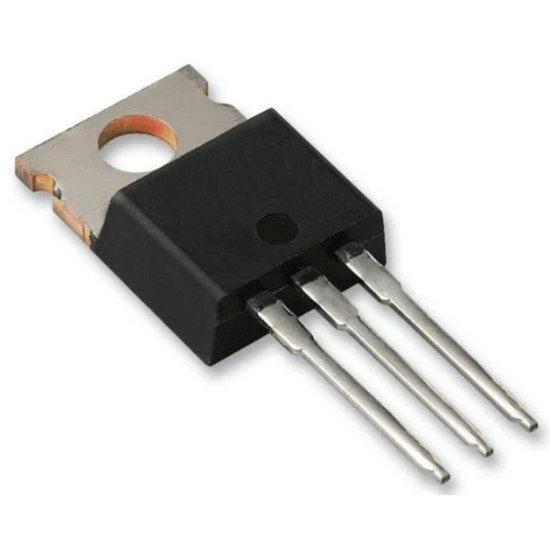 All Products, Power Supply, Voltage Regulator
All Products, Power Supply, Voltage RegulatorL78M05CV (L7805CV) TO-220 Linear Voltage Regulator (Pack of 3 ICs) Standard Quality
0 out of 5(0)- Fixed output voltage is 5V
- Output current is 0.5A
- Dropout voltage is 2V
- Maximum DC input voltage is 35V
- Output transition SOA protection
- Output voltage tolerance is 4%
SKU: IK-286 -
All Products, Power Supply, Voltage Regulator
L78M09CV (L7809CV) TO-220 Linear Voltage Regulator (Pack of 3 ICs) Standard Quality
 All Products, Power Supply, Voltage Regulator
All Products, Power Supply, Voltage RegulatorL78M09CV (L7809CV) TO-220 Linear Voltage Regulator (Pack of 3 ICs) Standard Quality
0 out of 5(0)- Fixed output voltage is 9V
- Output current is 0.5A
- Dropout voltage is 2V
- Maximum DC input voltage is 35V
- Output transition SOA protection
- Output voltage tolerance is 4%
- Operating temperature range 0°C to 125°C
SKU: IK-285 -
All Products, Passive Components, Power Supply, Voltage Regulator
Voltage Regulator IC LM7812 7812 IC 12V at Best Price
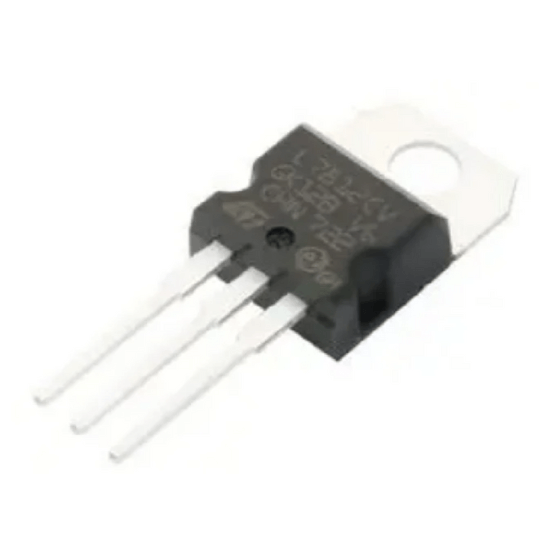 All Products, Passive Components, Power Supply, Voltage Regulator
All Products, Passive Components, Power Supply, Voltage RegulatorVoltage Regulator IC LM7812 7812 IC 12V at Best Price
0 out of 5(0)- No.of Outputs: 1 Outputs
- Max Output Current: 1,.5A
- Output Type: Fixed
- No.of Pins: 3 pins
SKU: IK-284 -
All Products, Arduino Boards
Arduino Uno R3 SMD Compatible Development Board(With cable)
0 out of 5(0)- Microcontroller ATmega328 (SMD) – Interface CH340G
- Operating Voltage: 5V
- Input Voltage (recommended): 7-12V
- Input Voltage (limits): 5-20V
- Digital I / O Pins 14 (of which 6 provide PWM output)
- Analog Input Pins: 6
SKU: IK-268
-
All Products, BO Motor, Motors & Mechanicals
BO Motor Wheel 34mm – Set of 2
0 out of 5(0)- These are the green BO motor wheels (2pcs)
- These wheels are of good quality
- The diameter of the wheel: 34mm
- The width of the wheel: 10mm (1cm)
- Screws can be fitted into the axle socket mounted from the front for keeping the wheel in place
- These wheels are used for robotics race
SKU: IK-230
Sensor & Modules
All Products, Custom Kits, IR Proximity/Motion, Miscellaneous, Sensors
Cartoon Ultrasonic Sensor Mounting Bracket For HC-SR04

All Products, Custom Kits, IR Proximity/Motion, Miscellaneous, Sensors
Cartoon Ultrasonic Sensor Mounting Bracket For HC-SR04
0 out of 5
(0)
Acrylic Body.
Easy to install.
compatible with HC-SR04
SKU: IK-227
All Products, AC-DC Converter, Battery, Current/Voltage, Power Supply, Sensors, Voltage Regulator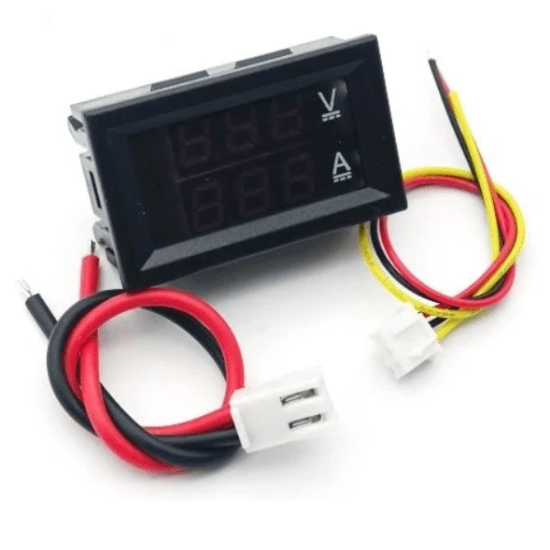
DC 100V 100A Voltmeter Ammeter 0.28″ 5 Wires Red Led Digital Dual Without Shunt at Best Price

All Products, AC-DC Converter, Battery, Current/Voltage, Power Supply, Sensors, Voltage Regulator
DC 100V 100A Voltmeter Ammeter 0.28″ 5 Wires Red Led Digital Dual Without Shunt at Best Price
0 out of 5
(0)
Operating Voltage: 5V DC
Current Consumption: <60mA
Testing Voltage: 0-100V
Testing Current: 1-100A
Easy to read even in dim light
SKU: IK-204
All Products, IR Proximity/Motion, Miscellaneous, Sensors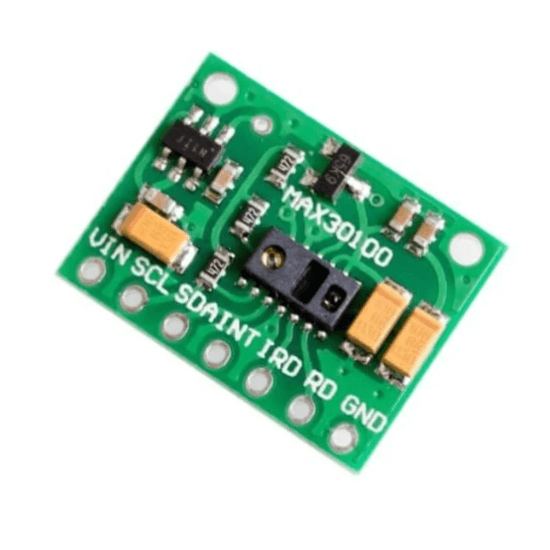
MAX30100 Pulse Oximeter Heart Rate Sensor Module at Best Price

All Products, IR Proximity/Motion, Miscellaneous, Sensors
MAX30100 Pulse Oximeter Heart Rate Sensor Module at Best Price
0 out of 5
(0)
Working Voltage:1.8 to 5.5 V
Shutdown Current:0.7µA
Color:Green
SKU: IK-196
All Products, Pressure/Touch, Sensors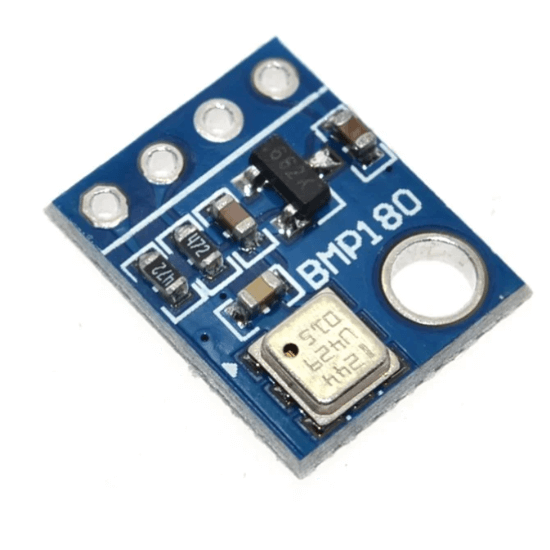
BMP180 Digital Barometric Sensor Module compatible with Arduino

All Products, Pressure/Touch, Sensors
BMP180 Digital Barometric Sensor Module compatible with Arduino
0 out of 5
(0)
1.8V to 3.6V Supply Voltage
Low power consumption – 0.5uA at 1Hz
I2C interface
Max I2C Speed: 3.5Mhz
Very low noise – up to 0.02hPa (17cm)
Fully calibrated
Pressure Range: 300hPa to 1100hPa (+9000m to -500m)
SKU: IK-191
All Products, Distance/Proximity, Force/Flex/Load, IR Proximity/Motion, Miscellaneous, Sensors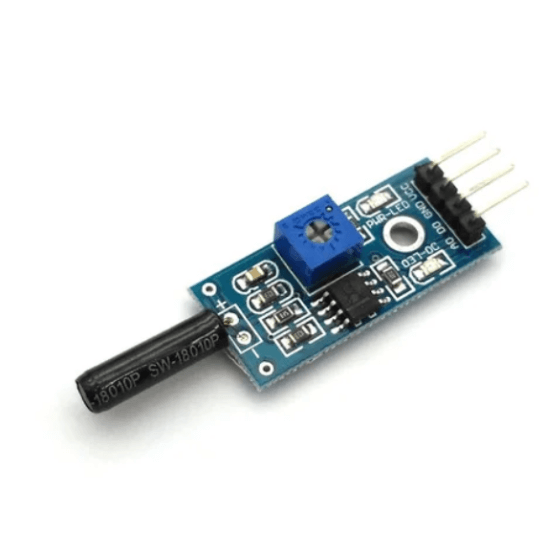
Tilt Sensor Vibration Alarm Vibration Switch Module for Arduino

All Products, Distance/Proximity, Force/Flex/Load, IR Proximity/Motion, Miscellaneous, Sensors
Tilt Sensor Vibration Alarm Vibration Switch Module for Arduino
0 out of 5
(0)
Operating voltage: 3.3 to 5VDC
Ball Rolling type of tilt sensor.
This small module is easy to use.
A fixed bolt hole for easy installation
Wide voltage LM393 comparator
SKU: IK-188
All Products, Sensors, Temperature
DS18B20 Water Proof Temperature Probe – Black (1m)
0 out of 5
(0)
A probe by new original installation import DS18B20 temperature sensor chip.
Stainless steel tube encapsulation waterproof moistureproof prevents rust.
Stainless steel shell (6 * 45 mm), lead length 100 mm (shielding wire) use stability;
3.0 V-5.5 V power supply;
Temperature range wide: -55 ℃ ~ + 125 ℃;
Without the external components, the unique single bus.
SKU: IK-179
All Products, Accessories, Accessories, Arduino, Development Boards, Miscellaneous, Sensors
ADS1115 16-Bit ADC- 4 Channel with Programmable Gain Amplifier Standard Quality

All Products, Accessories, Accessories, Arduino, Development Boards, Miscellaneous, Sensors
ADS1115 16-Bit ADC- 4 Channel with Programmable Gain Amplifier Standard Quality
0 out of 5
(0)
Wide Supply Range: 2.0v To 5.5v
Low Current Consumption
Continuous Mode: Only 150µa Single-shot
Auto Shut-down
Programmable Data Rate: 8SPS to 860SPS
It has Internal low-drift voltage reference
SKU: IK-172
All Products, IR Proximity/Motion, Magnetic/Vibration, Sensors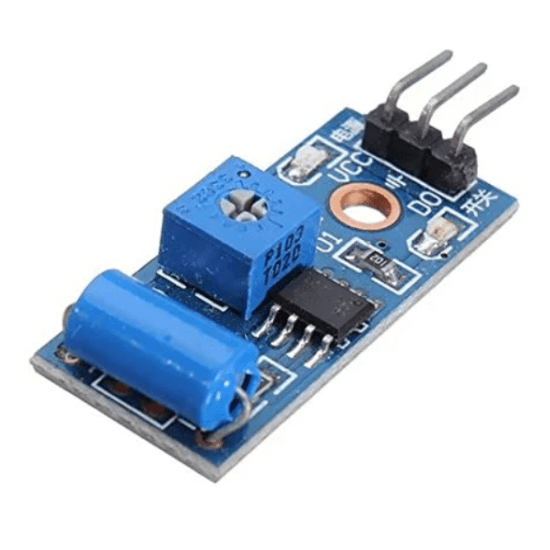
Best Vibration sensor module alarm Motion sensor module vibration switch SW-420

All Products, IR Proximity/Motion, Magnetic/Vibration, Sensors
Best Vibration sensor module alarm Motion sensor module vibration switch SW-420
0 out of 5
(0)
Using SW-420 normally closed type vibration sensor
Comparator output, clean signal, good waveform, strong driving ability, >15mA
Operating voltage 3.3V ~ 5V
Output format: digital switching output (0 and 1)
Using a wide voltage LM393 comparator
With bolt holes for easy installation
SKU: IK-165
All Products, Audio Components, Sensors, Speaker
MP3-TF-16P MP3 SD Card Module with Serial Port
0 out of 5
(0)
Supports sampling rates (KHz): 8 / 11.025 / 12/16 / 22.05 / 24/32 / 44.1 / 48
24-bit DAC output, dynamic range support: 90dB, SNR support: 85dB
Fully supports FAT16, FAT32 file system
Maximum support 32G TF card
Support U disk to 32G, 64M bytes of NORFLASH
A variety of control modes are available. IO control mode, serial mode, AD key control mode
SKU: IK-158
All Products, Accessories, Keyboard & Mouse, Pressure/Touch, Switches & Keypads
4×4 Matrix Keypad Membrane Switch for Arduino, ARM and other MCU

All Products, Accessories, Keyboard & Mouse, Pressure/Touch, Switches & Keypads
4×4 Matrix Keypad Membrane Switch for Arduino, ARM and other MCU
0 out of 5
(0)
Ultra-thin design & adhesive backing provides easy integration to any project
Excellent price-performance ratio
Easy communication with any microcontroller
5 pins 2.54mm pitch connector, 4x 4type 16 keys.
Sticker can peel off for adhesive mounting.
Operating Voltage (V): 12 DC
SKU: IK-138
All Products, Current/Voltage, Voltage Regulator
Voltage Detection Sensor Module 25V
0 out of 5
(0)
You can also use the IICLCD1602 LCD to display voltage.
By 3P connector, connect this module with the expansion of board Arduino
Voltage input range: DC 0-25 V
Voltage detection range: DC 0.02445 V to 25 V
Voltage analog resolution : 0.00489 V
SKU: IK-150
All Products, Pressure/Touch
TTP223 Capacitive Touch Sensor Module (2Pcs)
0 out of 5
(0)
Input Voltage : 2 Volt – 5.5 Volts DC.
The response time max ~ 60mS in fast mode, ~220mS at low power mode @VDD=3V.
Sensitivity can adjust by the capacitance(0~50pF).
Stable touching detection of the human body for replacing traditional direct switch key.
Provides direct mode toggle mode by pad option(TOG pin).
After power-on have about 0.5sec stable-time, during the time do not touch the keypad, and the function is disabled.
Auto calibration and Re-calibration period is about 4.0 sec when the key has not be touched.
SKU: IK-161
All Products, IR Proximity/Motion, Miscellaneous
TSOP1738 IR Receiver – Infrared Receiver at Best Price

All Products, IR Proximity/Motion, Miscellaneous
TSOP1738 IR Receiver – Infrared Receiver at Best Price
0 out of 5
(0)
Very low supply current
Photo-detector and preamplifier in one package
Internal filter for PCM frequency
Improved shielding against EMI
Supply voltage: 2.5 V to 5.5 V
Improved immunity against ambient light
SKU: IK-264
All Products, Heat Shrinks, Metal Heat Shrinks, Miscellaneous, Temperature
TEC1-12706 40x40mm Thermoelectric Cooler 6A Peltier Module Good Quality

All Products, Heat Shrinks, Metal Heat Shrinks, Miscellaneous, Temperature
TEC1-12706 40x40mm Thermoelectric Cooler 6A Peltier Module Good Quality
0 out of 5
(0)
Model number: TEC1-12706
Operating Voltage: 12V
Maximum Voltage Umax (V) : 15.4V
Maximum Current Imax (A) : 6A
Maximum Power: 92 W
Maximum Temperature: 138°C
Power Cord: 200mm
SKU: IK-123
All Products, Light/Colour
Buy TCS3200 Colour Sensor Recognition
0 out of 5
(0)
Operating Voltage: 3V-5V
High-resolution conversion of light intensity to frequency.
Chip pins all has drawn for standard 100.
Put the needle (2.54 mm).
Mil-convenient for bitmap board.
Programmable color and full-scale output frequency.
Communicate directly with a microcontroller.
Low-profile surface mount package.
SKU: IK-193
All Products, Force/Flex/Load, IR Proximity/Motion, Miscellaneous
Raindrops Detection Sensor Module No.1 Quality

All Products, Force/Flex/Load, IR Proximity/Motion, Miscellaneous
Raindrops Detection Sensor Module No.1 Quality
0 out of 5
(0)
Operating voltage: 5V
Provide both digital and analog output
Adjustable sensitivity
Output LED indicator
Compatible with Arduino
TTL Compatible
Bolt holes for easy installation
SKU: IK-183
All Products, Magnetic/Vibration, Pressure/Touch
Piezoelectric Sensor/Transducer/Buzzer – 35mm Diameter Standard Quality

All Products, Magnetic/Vibration, Pressure/Touch
Piezoelectric Sensor/Transducer/Buzzer – 35mm Diameter Standard Quality
0 out of 5
(0)
Color: Golden
Size: Approx. 35 x 35 x 0.5mm
Material: Copper and ceramic
Resonant impedance: max. 300 Ω
Static capacitance: 50000pF±30 percent
Resonant frequency: 1.8±0.3kHz
SKU: IK-263
All Products, Gas Sensor
MQ-9 Carbon Monoxide, Methane and LPG Gas Sensor Module Standard Quality
0 out of 5
(0)
Good sensitivity to CO/Combustible Gas
High sensitivity to Methane, Propane, and CO
Long life and low cost
Simple drive circuit
Input voltage: DC 5±0.2V
Current Consumption: 150mA
SKU: IK-262
All Products, Gas Sensor
MQ-8 Hydrogen Gas Sensor Module H2 Alarm Detection
0 out of 5
(0)
Using high-quality dual-panel design, with power indicator and TTL signal output instructions.
The switching signal having a DO (TTL) output and analog output AO.
TTL output valid signal is low.
The higher the voltage, the concentration of the analog output voltage is higher.
A hydrogen gas detection with good sensitivity.
Has a long life and reliable stability
SKU: IK-267
All Products, Gas Sensor
MQ-4 High Sensitivity Gas Methane (CNG) Detector Sensor Module
0 out of 5
(0)
Detecting range: 300~10000ppm
Signal output indicator.
Dual Signal output (analog output and TTL output).
The TTL output signal is low level, allows us to connect with SCM directly.
Analog output 0~5V voltage.
Quick response and recovery.
SKU: IK-259
All Products, Gas Sensor
MQ-3 Alcohol Gas Sensor Module
0 out of 5
(0)
Power requirements: 5 VDC @ ~165 mA (heater on) / ~60 mA (heater off).
Current Consumption: 150mA.
DO output: 0.1 and 5V.
AO output: 0.1- 0.3 V (relative to pollution), the maximum concentration of a voltage of about 4V
Detecting Concentration: 0.05-10mg/L Alcohol.
SKU: IK-181
All Products, Gas Sensor
MQ 135 Air Quality/Gas Detector Sensor Module For Arduino
0 out of 5
(0)
Sensitivity to Ammonia, Sulphide and Benzene steam
Sensitive for benzene, alcohol, smoke
Fast response and recovery
Adjustable sensitivity
Signal output indicator
Output voltage boosts along with the concentration of the measured gases increases.
SKU: IK-180
All Products, Accelerometer/Gyro
MPU-6050 3-Axis Accelerometer and Gyro Sensor Module
0 out of 5
(0)
Chip built-in 16bit AD converter, 16-bit data output
Driver Chip: MPU6050
Operating Voltage: 3-5V DC
Communication: I2C/IIC Protocol
Gyro Range: ± 250, 500, 1000, 2000 °/s
Accelerometer Range: ± 2 ± 4 ± 8 ± 16 g
SKU: IK-190
All Products, Distance/Proximity, Miscellaneous, Potentiometer
M274 Rotary Encoder 360 Degree Brick Sensor Module Good Quality

All Products, Distance/Proximity, Miscellaneous, Potentiometer
M274 Rotary Encoder 360 Degree Brick Sensor Module Good Quality
0 out of 5
(0)
Model : KY-040.
Type : Incremental Encoder.
Cycles per revolution (CPR) : 20.
Working voltage : 0 – 5V.
Material : PCB + Brass.
Mounting Nut Thread diameter: 6.6mm
Weight : 10 gm.
SKU: IK-175
Motor & Mechanicals
All Products, DC Motor, Motors & Mechanicals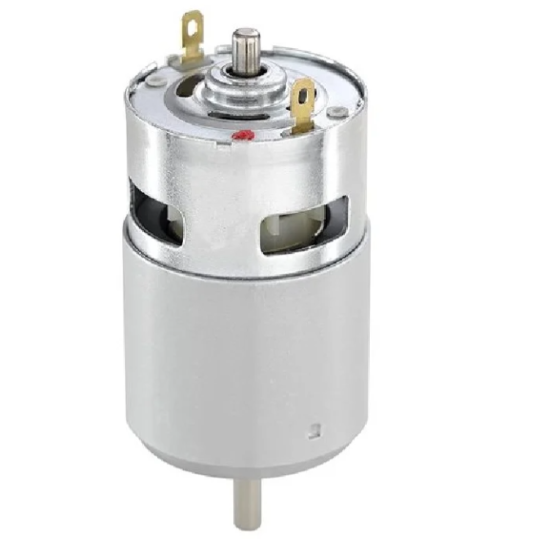
D Shaft 775 12V 6000 RPM/MIN High Speed High Torque DC Motor Dual Shaft Standard Quality

All Products, DC Motor, Motors & Mechanicals
D Shaft 775 12V 6000 RPM/MIN High Speed High Torque DC Motor Dual Shaft Standard Quality
0 out of 5
(0)
Voltage: 12V
Speed: 6000 RPM/MIN
Motor Type: DC Motor
Shaft Type: D Type
Shaft Length: 15mm
SKU: IK-335
All Products, BO Motor, Motors & Mechanicals
BO Motor Wheel 34mm – Set of 2
0 out of 5
(0)
These are the green BO motor wheels (2pcs)
These wheels are of good quality
The diameter of the wheel: 34mm
The width of the wheel: 10mm (1cm)
Screws can be fitted into the axle socket mounted from the front for keeping the wheel in place
These wheels are used for robotics race
SKU: IK-230
All Products, DC Fans, Gear Motor, Motors & Mechanicals
N20-6V-60 RPM Micro Metal Gear-box DC Motor
0 out of 5
(0)
This is a DC Mini Metal Gear Motor, ideal for making robots.
Lightweight, high torque and low RPM.
Fine craftsmanship, durable, not easy to wear.
With excellent stall characteristics, can climb hills easily.
You can also easily mount a wheel on the motor’s output shaft.
SKU: IK-219
All Products, BO Motor, Motors & Mechanicals, Robot Kits
65mm Robot Wheel for BO Motors (Yellow)
0 out of 5
(0)
Tire with sponge liner for more strength
With upgraded tire tread for greater friction
New design wheel for better combination with the motor
Diameter: 65 mm
Width : 28 mm
The material of Wheel: High-strength plastic
The material of Tyre: Rubber
Color: Yellow
SKU: IK-207
All Products, DC Pumps, Motors & Mechanicals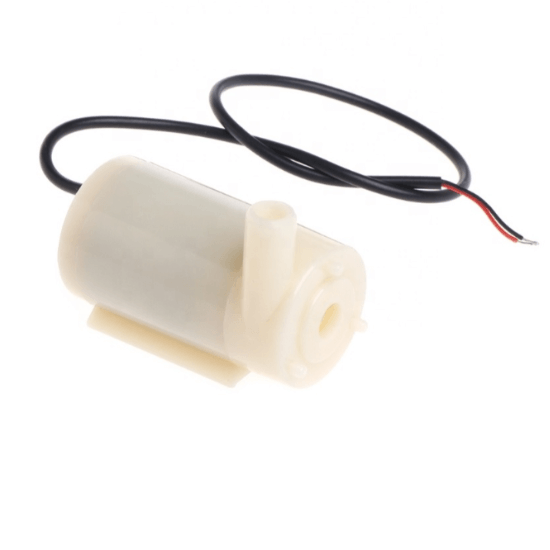
Mini Submersible Pump Horizontal Mute Sounds DC 3V-5V at Best Price

All Products, DC Pumps, Motors & Mechanicals
Mini Submersible Pump Horizontal Mute Sounds DC 3V-5V at Best Price
0 out of 5
(0)
DC voltage: 2.5-6V
Maximum lift: 40-110cm/15.75″-43.4″
Flow rate: 80-120L/H
Outer diameter of effluent: 7.5mm/0.3″
SKU: IK-206
All Products, Accessories, Motors & Mechanicals, Power Supply
L298n Motor Driver 2A Based Module – Good Quality

All Products, Accessories, Motors & Mechanicals, Power Supply
L298n Motor Driver 2A Based Module – Good Quality
0 out of 5
(0)
Current Sense for each motor.
Heatsink for better performance.
Power-On LED indicator.
Double H bridge Drive Chip: L298N.
Operating Voltage(VDC): 5~35
Peak Current (A): 2
Continuous Current (A): 0-36mA
No. of Channels: 2
Over-Current Protection (A): Yes
Thermal Protection: Yes
SKU: IK-132
All Products, Servo Motor/Controller
ULN2003 Stepper Motor Driver Module
0 out of 5
(0)
ULN2003A motor driver chip
Chip all the pins already leads for easy connection to use
5-12V power supply
4-way signal indicator
Step angle: 5.625 x 1 / 64
Reduction ratio: 1 / 64
Phase: 4
Current / Phase: 5V
SKU: IK-238
All Products, Servo Motor/Controller
TowerPro SG90 Continuous Rotation 360 Degree Servo Motor Standard Quality

All Products, Servo Motor/Controller
TowerPro SG90 Continuous Rotation 360 Degree Servo Motor Standard Quality
0 out of 5
(0)
Model: SG90
Weight: 9 gm
Operating voltage: 3.0V~ 7.2V
Servo Plug: JR
Stall torque @4.8V : 1.2kg-cm
SKU: IK-126
All Products, Servo Motor/Controller
Towerpro sg90 servo motor – 180 degree Rotation – Standard Quality

All Products, Servo Motor/Controller
Towerpro sg90 servo motor – 180 degree Rotation – Standard Quality
0 out of 5
(0)
Model: SG90
Weight: 9 gm
Operating voltage: 3.0V~ 7.2V
Servo Plug: JR
Stall torque @4.8V : 1.2kg-cm
Stall torque @6.6V : 1.6kg-cm
SKU: IK-125
All Products, Servo Motor/Controller
TowerPro MG995 Metal Gear Servo Motor (180° Rotation)-Good Quality

All Products, Stepper Motor/ Controller
16-Channel 12-bit PWM/Servo Driver I2C interface PCA9685 for Arduino Raspberry Pi

All Products, Stepper Motor/ Controller
16-Channel 12-bit PWM/Servo Driver I2C interface PCA9685 for Arduino Raspberry Pi
0 out of 5
(0)
Adjustable frequency PWM up to about 1.6 KHz
12-bit resolution for each output – for servos, that means about 4us resolution at a 60Hz update rate
Configurable push-pull or an open-drain output
The output enable pin to quickly disable all the outputs
Terminal block for power input
Reverse polarity protection on the terminal block input
Green power-good LED
SKU: IK-127
All Products, Motors/ESC/Controller, Servo Motor/Controller
Digital Multi Servo Tester ESC RC-1 Consistency CCPM Master Speed Control

All Products, Motors/ESC/Controller, Servo Motor/Controller
Digital Multi Servo Tester ESC RC-1 Consistency CCPM Master Speed Control
0 out of 5
(0)
Operating Voltage: DC 4.8-6V
Offer 3 modes to check servos or ESC
The Manual Mode allows you to turn the knob to different speeds and check the reaction time
The Neutral mode makes the servo go back to the neutral point
The Automatic ’’Window Wiper’’ Mode makes the servo swing like a window wiper in the largest angle possible
Connect to up to 3 servos simultaneously
SKU: IK-128
All Products, 12v Relay, Miscellaneous, Motors & Mechanicals
DC 12V Cabinet Door Lock Solenoid Electromagnetic Standard Quality

All Products, 12v Relay, Miscellaneous, Motors & Mechanicals
DC 12V Cabinet Door Lock Solenoid Electromagnetic Standard Quality
0 out of 5
(0)
Holding force: 0.25 kg
Energized forms: intermittent
Unlocking time: 1s
Dimensions: 54 x 42 x 28 mm (LxWxH)
High quality ultra-compact electric lock.
SKU: IK-192
All Products, Arduino Shields, Motor Drivers, Stepper Motor/ Controller
A4988 driver Stepper Motor Driver at Best Price

All Products, Arduino Shields, Motor Drivers, Stepper Motor/ Controller
A4988 driver Stepper Motor Driver at Best Price
0 out of 5
(0)
Supply Voltage : 8-35 VDC.
Current : 1.0A (no heatsink ).
Current : 2.0A (with heat-sinking).
logic input : 3 – 5.5V .
Automatic current decay mode detection / choice.
Mixed with slow current decay mode.
SKU: IK-216
All Products, BO Motor
60 RPM BO Motor – Straight
0 out of 5
(0)
Low density: lightweight, low inertia.
Capability to absorb shock and vibration as a result of elastic compliance.
Ability to operate with minimum or no lubrication, due to inherent lubricity.
The relatively low coefficient of friction.
Operating Voltage(VDC): 3~12
Shaft Length (mm): 8.5
Shaft Diameter (mm): 5.5 (Double D-type)
No Load Current: 40-180mA.
Rated Speed(After Reduction): 100 RPM
Rated Torque: 1 Kgcm
SKU: IK-208
All Products, BO Motor
100 RPM BO Motor- L Shape
0 out of 5
(0)
Low density: lightweight, low inertia.
Capability to absorb shock and vibration as a result of elastic compliance.
Ability to operate with minimum or no lubrication, due to inherent lubricity.
The relatively low coefficient of friction.
Operating Voltage(VDC): 3~12
Shaft Length (mm): 8.5
Shaft Diameter (mm): 5.5 (Double D-type)
No Load Current: 40-180mA.
Rated Speed(After Reduction): 100 RPM
Rated Torque: 0.8 Kgcm
SKU: IK-210
Power Supply & Battery
All Products, Adapter, Power Supply, SMPS
Standard DC Plug 5V 1A Power Supply with 5.5mm at Best Price

All Products, Adapter, Power Supply, SMPS
Standard DC Plug 5V 1A Power Supply with 5.5mm at Best Price
0 out of 5
(0)
Input Voltage (V): 100 ~ 280 VAC @50 ~ 60Hz.
Input current (mA): 100.
Output Power: 5V 1A.
Input Plug: 2-Pin EU type.
Output Plug: 5.5mm DC plug.
SKU: IK-334
All Products, Adapter, Power Supply, SMPS
SMPS Power Adaptor – 12V/2A (Power supply) at Best Price
0 out of 5
(0)
Input Voltage: 100-240VAC, 50/60Hz
Output: 12V 2A
Output Adapter: 5.5mm x 2.5mm
PWM design, make sure the stability and high efficiency of power supply.
Anti-jamming, passed EMC test, wave less than 20MV.
Efficiency above 80%, exotherm less than 25 degree
Function: with overvoltage protection, short-circuit protection, overload protection
Non-waterproof
SKU: IK-333
All Products, Power Supply, Voltage Regulator
L78M05CV (L7805CV) TO-220 Linear Voltage Regulator (Pack of 3 ICs) Standard Quality

All Products, Power Supply, Voltage Regulator
L78M05CV (L7805CV) TO-220 Linear Voltage Regulator (Pack of 3 ICs) Standard Quality
0 out of 5
(0)
Fixed output voltage is 5V
Output current is 0.5A
Dropout voltage is 2V
Maximum DC input voltage is 35V
Output transition SOA protection
Output voltage tolerance is 4%
SKU: IK-286
All Products, Power Supply, Voltage Regulator
L78M09CV (L7809CV) TO-220 Linear Voltage Regulator (Pack of 3 ICs) Standard Quality

All Products, Power Supply, Voltage Regulator
L78M09CV (L7809CV) TO-220 Linear Voltage Regulator (Pack of 3 ICs) Standard Quality
0 out of 5
(0)
Fixed output voltage is 9V
Output current is 0.5A
Dropout voltage is 2V
Maximum DC input voltage is 35V
Output transition SOA protection
Output voltage tolerance is 4%
Operating temperature range 0°C to 125°C
SKU: IK-285
All Products, Passive Components, Power Supply, Voltage Regulator
Voltage Regulator IC LM7812 7812 IC 12V at Best Price

All Products, Passive Components, Power Supply, Voltage Regulator
Voltage Regulator IC LM7812 7812 IC 12V at Best Price
0 out of 5
(0)
No.of Outputs: 1 Outputs
Max Output Current: 1,.5A
Output Type: Fixed
No.of Pins: 3 pins
SKU: IK-284
All Products, Battery, Battery Holder
Cell Box/Black Plastic Storage Box Case Holder For Battery 3 x 18650, Without Cover Standard Quality

All Products, Battery, Battery Holder
Cell Box/Black Plastic Storage Box Case Holder For Battery 3 x 18650, Without Cover Standard Quality
0 out of 5
(0)
Hold 3 standard 18650 batteries.
Wire Length: 15 cm.
Output: 11.1 V.
Dimension (Appro.) : 76 x 60 x 18 mm.
Weight: 18 gm.
High-quality plastic material
SKU: IK-213
All Products, Battery, Battery Holder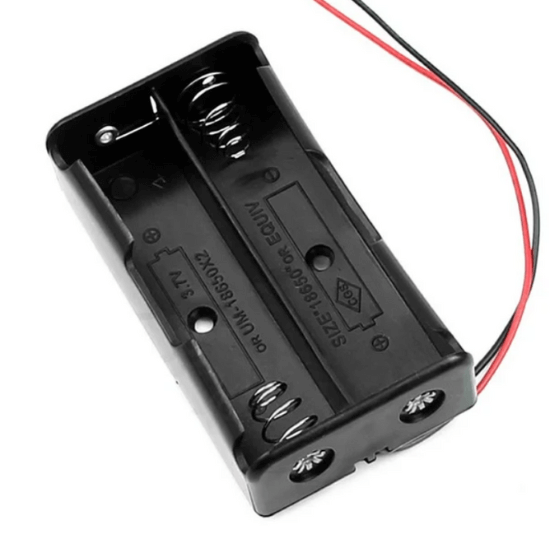
Black Plastic Storage Box Case Holder For Battery 2 x 18650 Cell Box, without cover Standard Quality

All Products, Battery, Battery Holder
Black Plastic Storage Box Case Holder For Battery 2 x 18650 Cell Box, without cover Standard Quality
0 out of 5
(0)
Hold 2 standard 18650 batteries.
Wire Length: 15 cm.
Output: 7.2v.
Dimension (Appro.) : 76 x 40 x 20 mm
Weight: 12gm
High-quality plastic material
SKU: IK-212
All Products, Battery, Battery Holder
Black Plastic Storage Box Case Holder For Battery 1 x 18650 Cell Box -2pcs

All Products, Battery, Battery Holder
Black Plastic Storage Box Case Holder For Battery 1 x 18650 Cell Box -2pcs
0 out of 5
(0)
Hold A standard 18650 batteries
Wire : 15cm
Output: 3.7v
Dimension (Appro.): 76x20x20xmm
Weight: 8gm
High-quality plastic material
SKU: IK-211
All Products, Adapter, Battery, Cables & Connector, Connector, Prototyping & Misc
2.1×5.5mm DC Power Jack Socket Panel Mount (Female) – 5pcs at Best Price

All Products, Adapter, Battery, Cables & Connector, Connector, Prototyping & Misc
2.1×5.5mm DC Power Jack Socket Panel Mount (Female) – 5pcs at Best Price
0 out of 5
(0)
Widely used in small-scale as well as prototyping projects where 12 to 30 volts power supply needed
Supports DC Power Jack: 2.1 x 5.5 mm
Diameter: 14mm
SKU: IK-203
All Products, Adapter, Battery, Cables & Connector, Power Supply, Prototyping & Misc
DC-005 5.5×2.1mm DC Power Jack Supply Socket Female-5Pcs Standard Quality

All Products, Adapter, Battery, Cables & Connector, Power Supply, Prototyping & Misc
DC-005 5.5×2.1mm DC Power Jack Supply Socket Female-5Pcs Standard Quality
0 out of 5
(0)
Plug Type: 5.5 x 2.1mm
Pin: 3
Temperature: -30°C ~ +70°C.
Rated load: up to DC 30V / 1.0A.
Contact resistance: ≤0.03.
Insulation resistance: ≥100 MΩ.
SKU: IK-205
All Products, AC-DC Converter, Battery, Current/Voltage, Power Supply, Sensors, Voltage Regulator
DC 100V 100A Voltmeter Ammeter 0.28″ 5 Wires Red Led Digital Dual Without Shunt at Best Price

All Products, AC-DC Converter, Battery, Current/Voltage, Power Supply, Sensors, Voltage Regulator
DC 100V 100A Voltmeter Ammeter 0.28″ 5 Wires Red Led Digital Dual Without Shunt at Best Price
0 out of 5
(0)
Operating Voltage: 5V DC
Current Consumption: <60mA
Testing Voltage: 0-100V
Testing Current: 1-100A
Easy to read even in dim light
SKU: IK-204
All Products, Battery, Battery Charger, BMS(Battery Management System), Li-ion Battery
5V Step-Up Power Module Lithium Battery Charging Protection Board USB For DIY Charger

All Products, Battery, Battery Charger, BMS(Battery Management System), Li-ion Battery
5V Step-Up Power Module Lithium Battery Charging Protection Board USB For DIY Charger
0 out of 5
(0)
BAT Discharging Stop Voltage:2.9V
Discharging Efficiency:85%(input 3.7V output 5V/1A)
Charging and discharging indication
Internally installed charging and discharging power MOS
Preset 4.2V charging voltage, precision ±1%
Max 8uA standby current
Integration charging management and discharging management
Intelligent temperature control and overtemperature protection
Integration output overvoltage protection, short circuit protection, overload protection
SKU: IK-171
All Products, Battery, BMS(Battery Management System)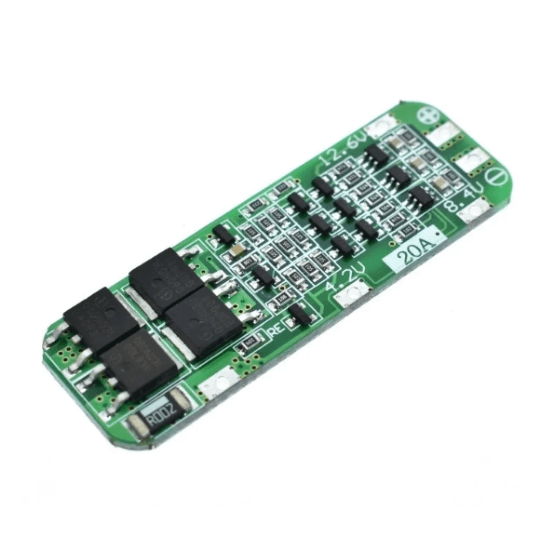
3 Series 20A 18650 Lithium Battery Protection Board 11.1V 12V 12.6V

All Products, Battery, BMS(Battery Management System)
3 Series 20A 18650 Lithium Battery Protection Board 11.1V 12V 12.6V
0 out of 5
(0)
3S 11.1V 12.6V 20A 18650 lithium battery protection board (comes with recovery function-AUTO Recovery).
Application: Nominal voltage of 3.6V, 3.7V lithium battery (including 18650.26650, a polymer lithium battery).
Continuous discharge current (upper limit): 20A (if the cooling environment is not good, please reduce the load current use).
Continuous charge current (upper limit): 20A.
Suitable for the drills with starting current below 80A, power below 135W
SKU: IK-170
All Products, Battery Charger, BMS(Battery Management System), Power Supply, Voltage Regulator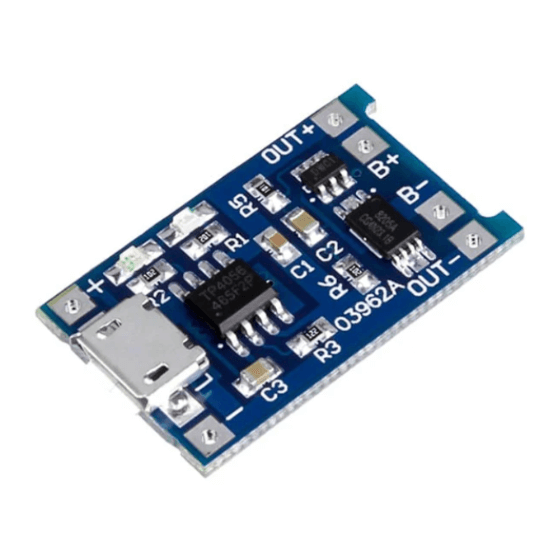
TP4056 1A Li-Ion Battery Charging Board Micro USB with Current Protection Standard Quality

All Products, Battery Charger, BMS(Battery Management System), Power Supply, Voltage Regulator
TP4056 1A Li-Ion Battery Charging Board Micro USB with Current Protection Standard Quality
0 out of 5
(0)
Dimension: 25 x 19 x 10 (LxWxH)mm.
Input interface: micro USB.
Current Protection: Yes
Charging mode: Linear charging.
Current: 1A adjustable.
Charge precision: 1.5%.
Input voltage: 4.5V-5.5V.
Full charge voltage: 4.2V.
SKU: IK-152
All Products, Buck/Boast Converter, Power Supply
XL4015 5A DC-DC Step Down Adjustable Power Supply Buck Module LED with Heatsink Good Quality

All Products, Buck/Boast Converter, Power Supply
XL4015 5A DC-DC Step Down Adjustable Power Supply Buck Module LED with Heatsink Good Quality
0 out of 5
(0)
Input voltage range: 4V-38V DC
Output voltage range: 1.25V-36V DC adjustable.
Output current: 0-5A.
Output power: 75W.
High efficiency up to 96%
The built-in thermal shutdown function
Built-in current limit function
In-Built output short protection function
SKU: IK-144
All Products, Accessories, Motors & Mechanicals, Power Supply
L298n Motor Driver 2A Based Module – Good Quality

All Products, Accessories, Motors & Mechanicals, Power Supply
L298n Motor Driver 2A Based Module – Good Quality
0 out of 5
(0)
Current Sense for each motor.
Heatsink for better performance.
Power-On LED indicator.
Double H bridge Drive Chip: L298N.
Operating Voltage(VDC): 5~35
Peak Current (A): 2
Continuous Current (A): 0-36mA
No. of Channels: 2
Over-Current Protection (A): Yes
Thermal Protection: Yes
SKU: IK-132
All Products, AC-DC Converter, Hi-Link Power Supply, Power Supply
Hi-link HLK PM12 12V/3W Switch Power Supply Module

All Products, AC-DC Converter, Hi-Link Power Supply, Power Supply
Hi-link HLK PM12 12V/3W Switch Power Supply Module
0 out of 5
(0)
Meet UL, CE requirements,
Ultra-thin, ultra-small
All voltage input (AC: 90 ~ 264V)
Low ripple and low noise
Output overload and short circuit protection
High efficiency, high power density
The product is designed to meet the requirements of EMC and Safety Test
SKU: IK-108
All Products, AC-DC Converter, Hi-Link Power Supply, Power Supply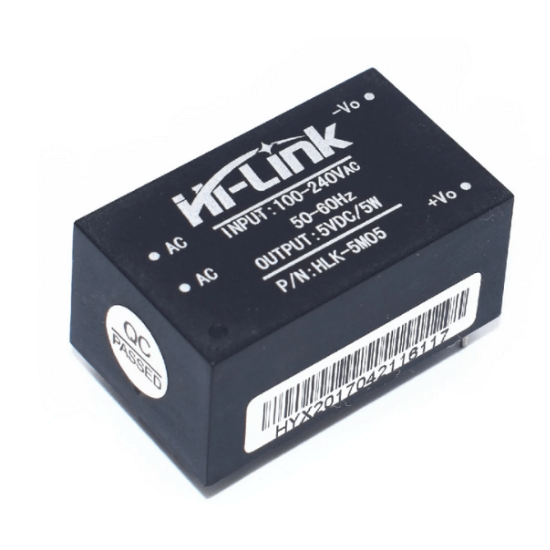
Hi-Link HLK 5M05 5V/5W Switch Power Supply Module

All Products, AC-DC Converter, Hi-Link Power Supply, Power Supply
Hi-Link HLK 5M05 5V/5W Switch Power Supply Module
0 out of 5
(0)
Meet UL, CE requirements,
Ultra-thin, ultra-small
All voltage input (AC: 90 ~ 264V)
Low ripple and low noise
Output overload and short circuit protection
High efficiency, high power density
The product is designed to meet the requirements of EMC and Safety Test
Low power consumption, environmental protection, no-load loss <0.1W
Works without external circuit.
SKU: IK-107
All Products, Li-ion Battery
18650 1200maH Lithium Ion Battery – 0.5C Rating – 200 cycle Standard Quality

All Products, Li-ion Battery
18650 1200maH Lithium Ion Battery – 0.5C Rating – 200 cycle Standard Quality
0 out of 5
(0)
1200mah Lithium Ion Battery
Life Cycle: 200 Cycles
Charge / Discharge Rating: 0.5C
Form Factor: 18650
SKU: IK-265
All Products, Current/Voltage, Voltage Regulator
Voltage Detection Sensor Module 25V
0 out of 5
(0)
You can also use the IICLCD1602 LCD to display voltage.
By 3P connector, connect this module with the expansion of board Arduino
Voltage input range: DC 0-25 V
Voltage detection range: DC 0.02445 V to 25 V
Voltage analog resolution : 0.00489 V
SKU: IK-150
All Products, Buck/Boast Converter, DC-DC Converter
XY-016 2A DC-DC Step Up 5V/9V/12V/28V Power Module with Micro USB

All Products, Buck/Boast Converter, DC-DC Converter
XL6009 DC-DC Step-Up Converter Ultra LM2577 Booster Circuit Board Standard Quality

All Products, Buck/Boast Converter, DC-DC Converter
XL6009 DC-DC Step-Up Converter Ultra LM2577 Booster Circuit Board Standard Quality
0 out of 5
(0)
The performance is much higher than LM2577.
Non-isolated Boost converter.
It has a non-synchronous rectifier.
Low ultra wide input voltage 3 v ~ 32 v, the best is 5 ~ 32 v working voltage range;
Low ultra wide output voltage 5 v ~ 35 v;
SKU: IK-143
All Products, Buck/Boast Converter, DC-DC Converter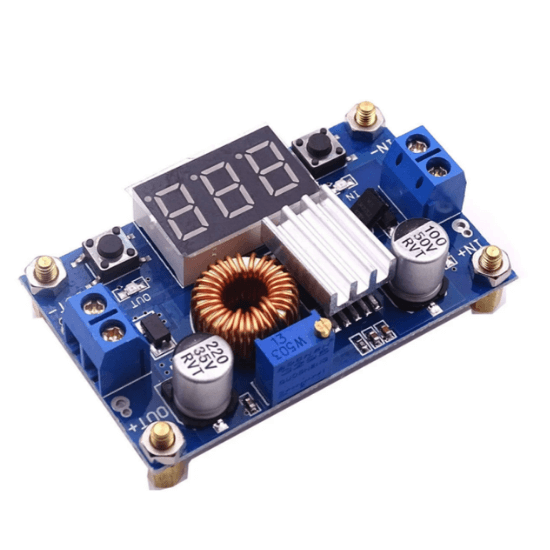
XL4015 5A Step Down Adjustable Power Supply with LED Voltmeter

All Products, Buck/Boast Converter, DC-DC Converter
XL4015 5A Step Down Adjustable Power Supply with LED Voltmeter
0 out of 5
(0)
Better than 2596, easy to 4A 50W, up to 75W adding the heat sink.
Over-temperature protection: Yes (shutdown output automatically after over temperature).
Input voltage: 4V ~ 38V (not more than 38V).
Output voltage: 1.25V ~ 36V (adjustable).
Output current: 0A ~ 5A (recommended below 4.5A).
SKU: n/a
All Products, Buck/Boast Converter, DC-DC Converter
XL4015 5A DC-DC Step Down Adjustable Power Supply Buck Module with Heatsink

All Products, Buck/Boast Converter, DC-DC Converter
XL4015 5A DC-DC Step Down Adjustable Power Supply Buck Module with Heatsink
0 out of 5
(0)
Input voltage range: 4V-38V DC
Output voltage range: 1.25V-36V DC adjustable.
Output current: 0-5A.
Output power: 75W.
High efficiency up to 96%
The built-in thermal shutdown function
Built-in current limit function
In-Built output short protection function
SKU: n/a
All Products, Buck/Boast Converter, DC-DC Converter
MT3608 2A Max DC-DC Step Up Power Module Booster Power Module

All Products, Buck/Boast Converter, DC-DC Converter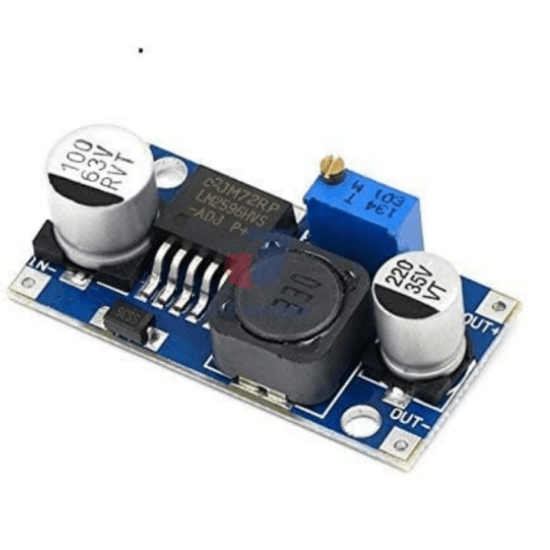
LM2596HVS DC-DC Buck Converter 4.5-50V to 3-40V Adjustable Step Down Power Module

All Products, Buck/Boast Converter, DC-DC Converter
LM2596HVS DC-DC Buck Converter 4.5-50V to 3-40V Adjustable Step Down Power Module
0 out of 5
(0)
Input voltage: 4.5-50V,
Output voltage: (3-35V) continuously adjustable (recommended load debugging).
Output current: rated current 2A, 3A maximum
Output Power: 15W maximum
SKU: n/a
All Products, Buck/Boast Converter, DC-DC Converter
LM2596S DC-DC Buck Converter Power Supply Standard Quality

All Products, Buck/Boast Converter, DC-DC Converter
LM2596S DC-DC Buck Converter Power Supply Standard Quality
0 out of 5
(0)
Input voltage: 3-40V
Output voltage: 1.5-35V(Adjustable)
Output current: Rated current is 2A, maximum 3A
Switching Frequency: 150KHz
Operating temperature:Industrial grade (-40 to +85 )
Conversion efficiency: 92%(highest)
SKU: IK-145
INVENTKART is India’s most Trusted Robotics and DIY Store
Pan India Shipping
Free Shipping over ₹999
Cash On Delivery
*Payments for major pincodes all over the India
Quick Support
Support Timings : Mon to Sat 10am to 6pm








